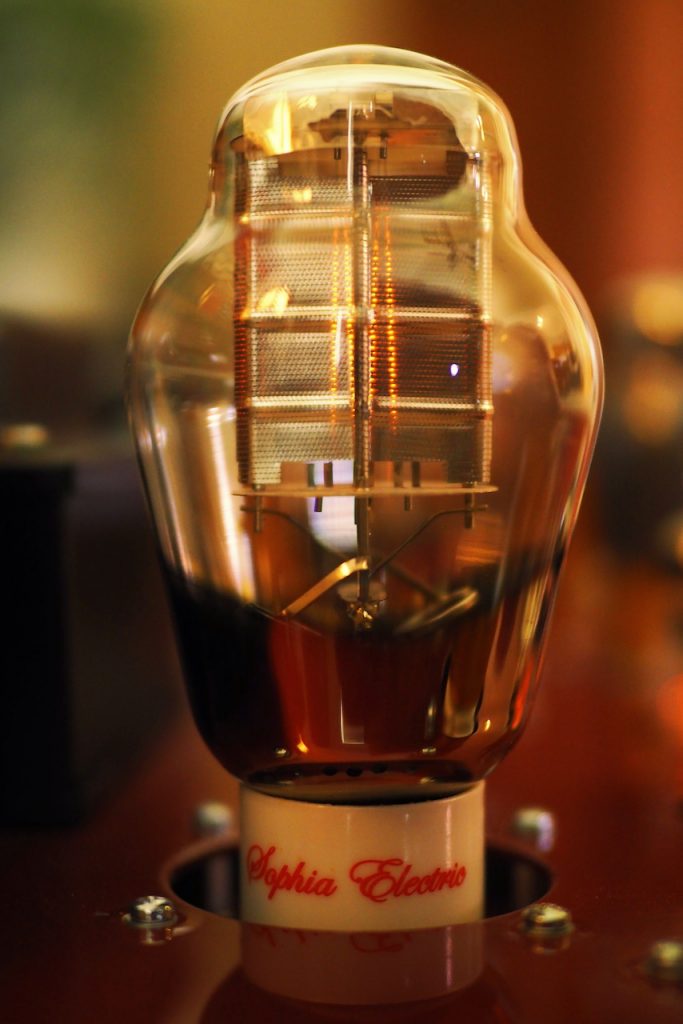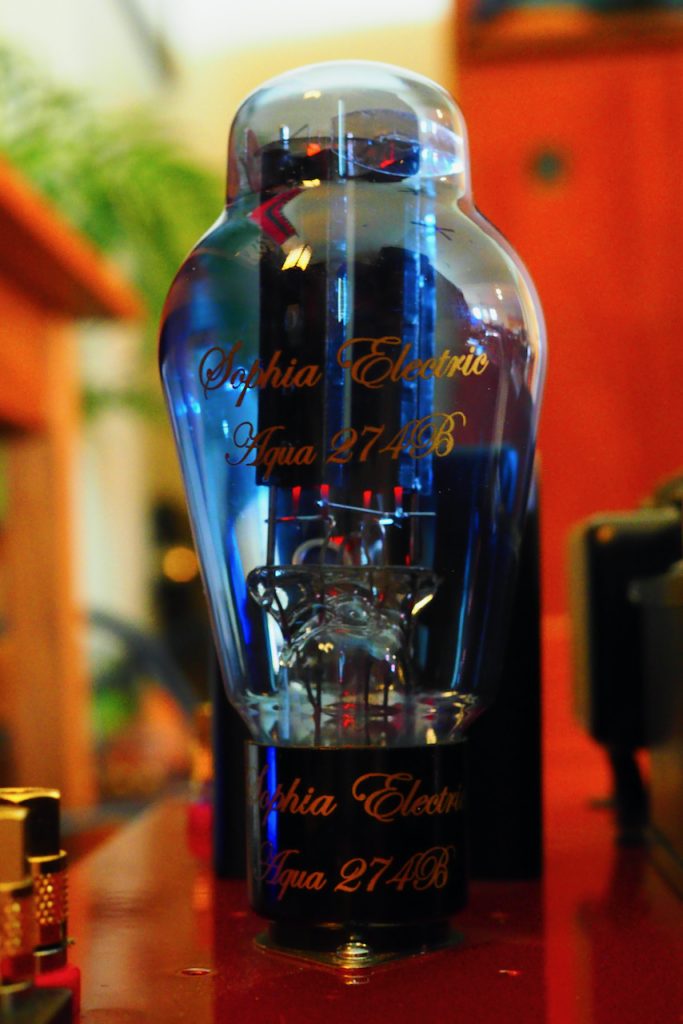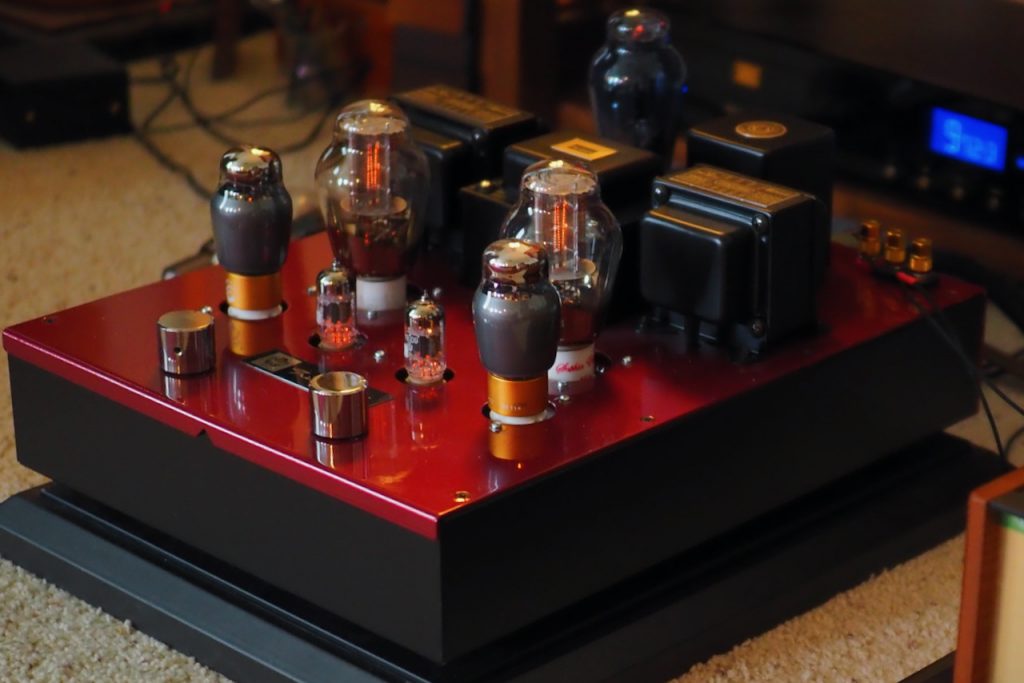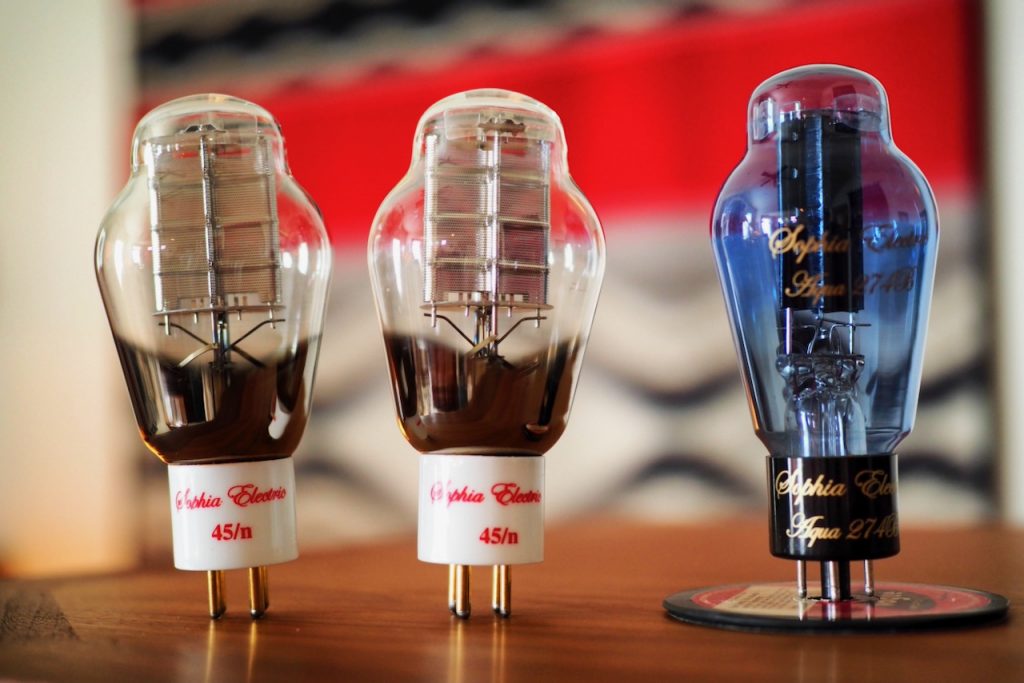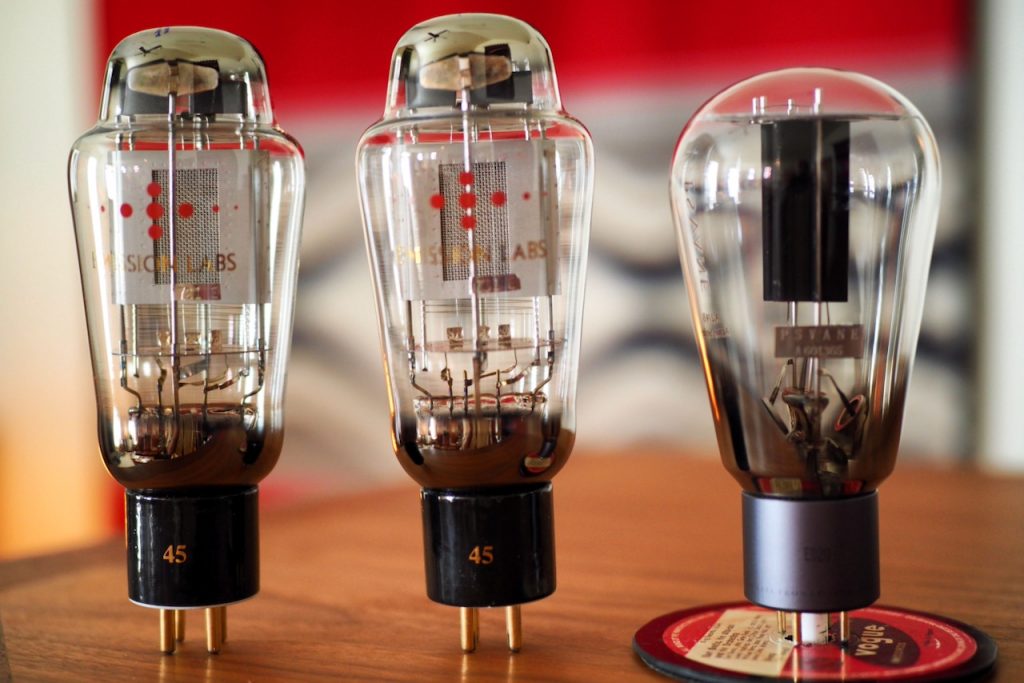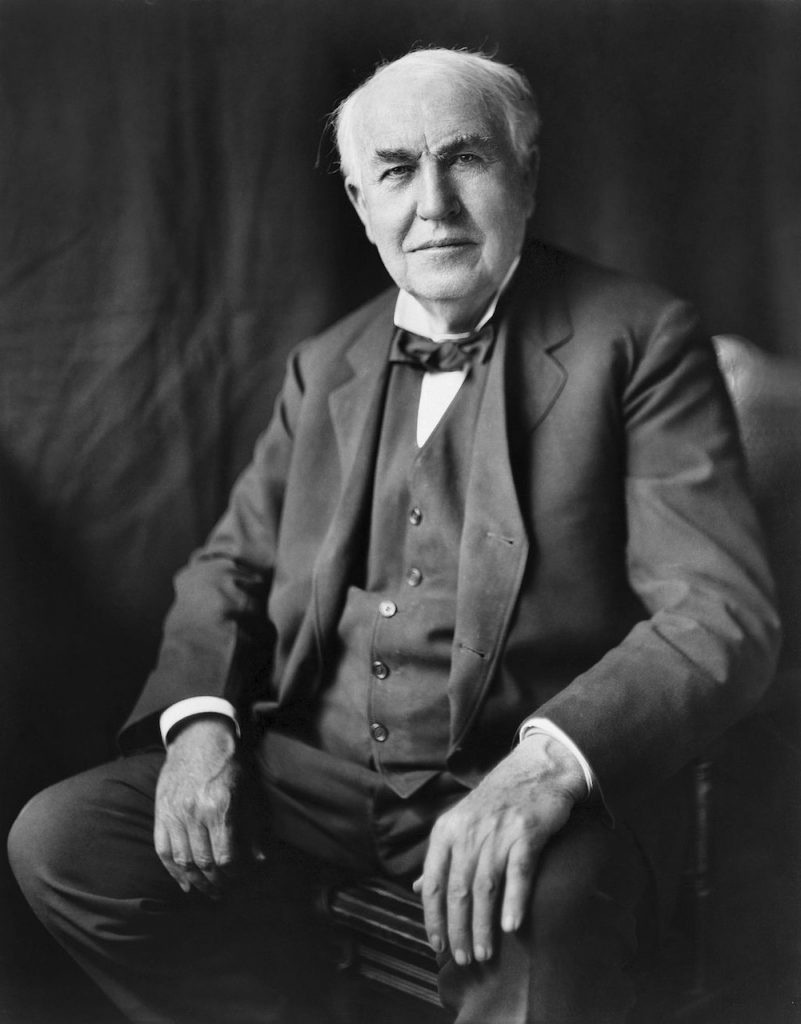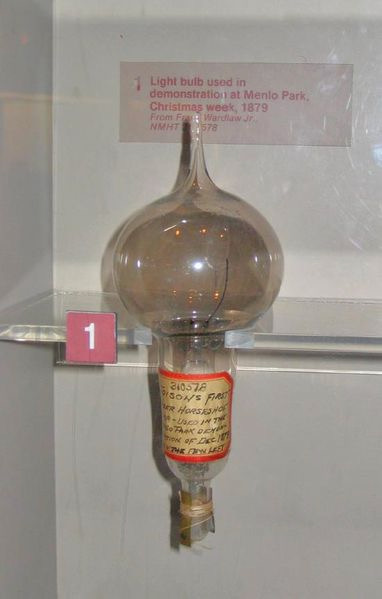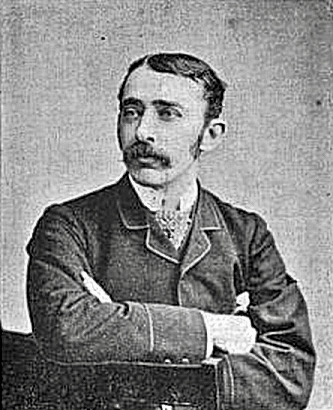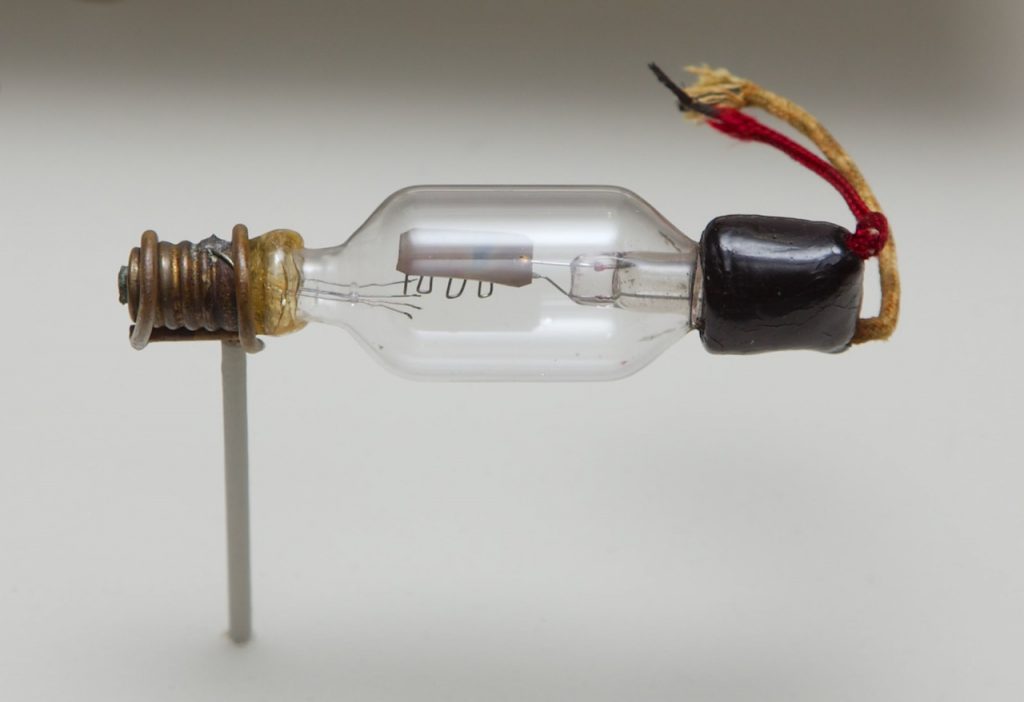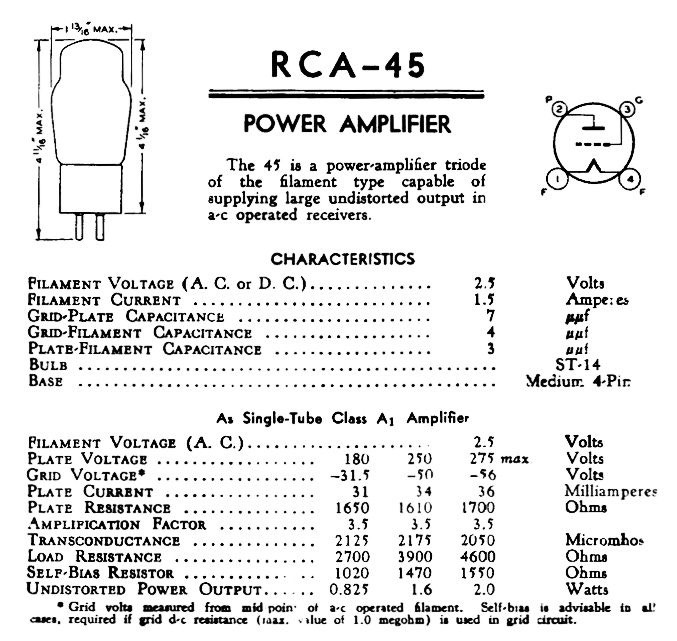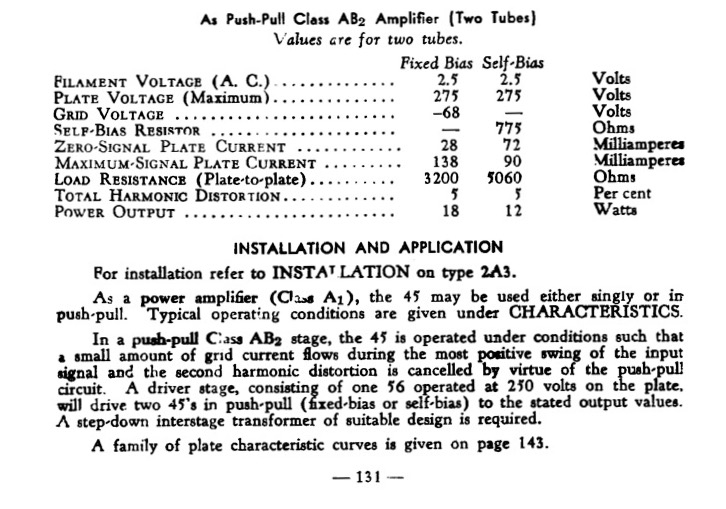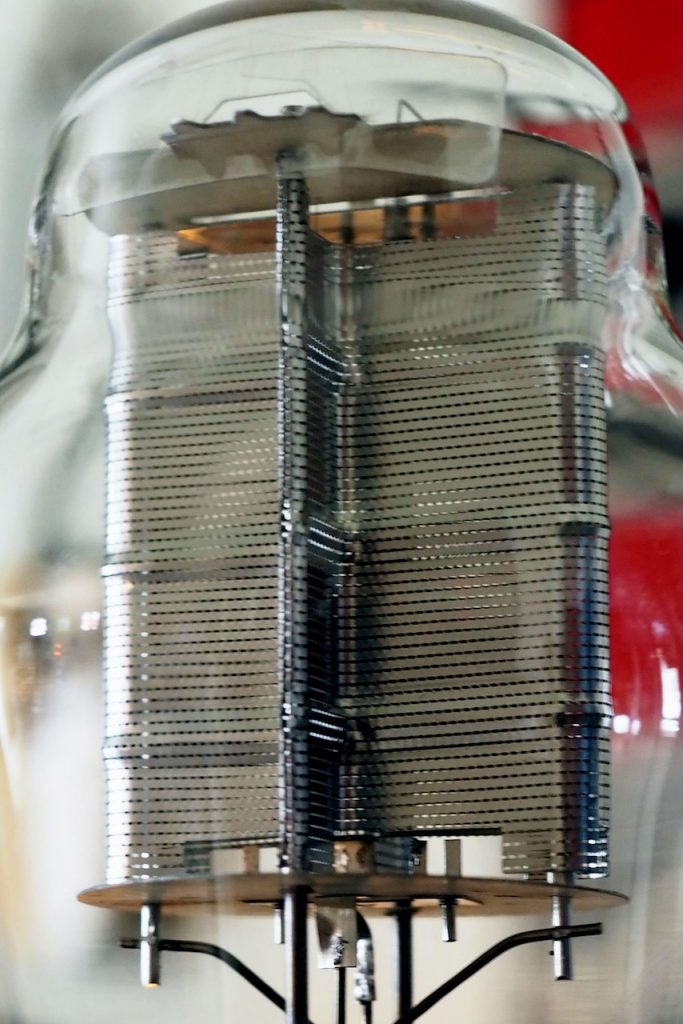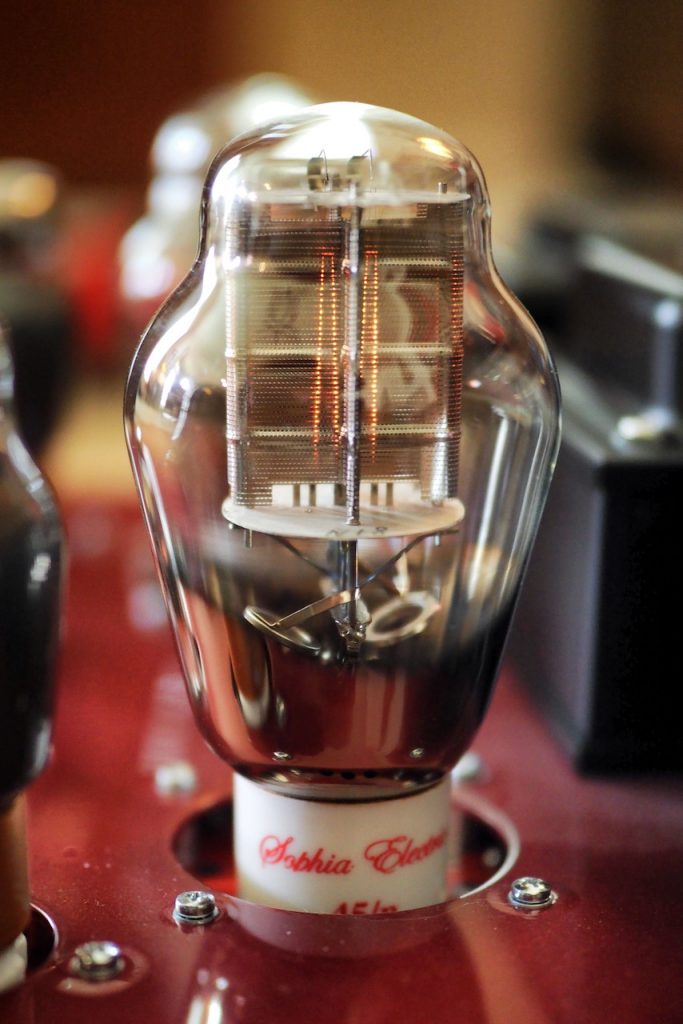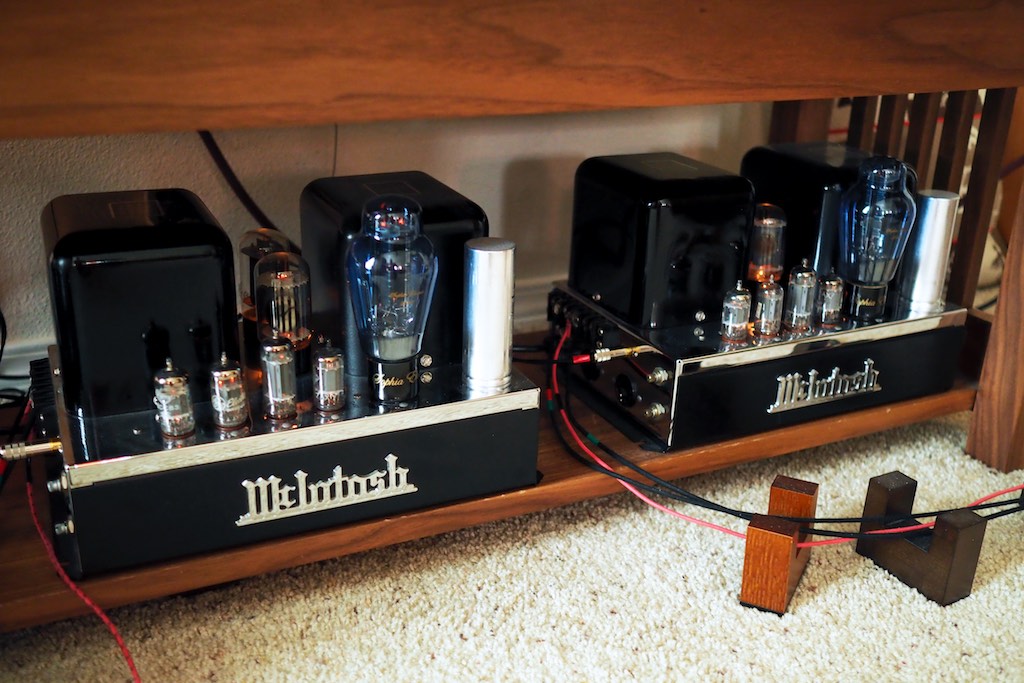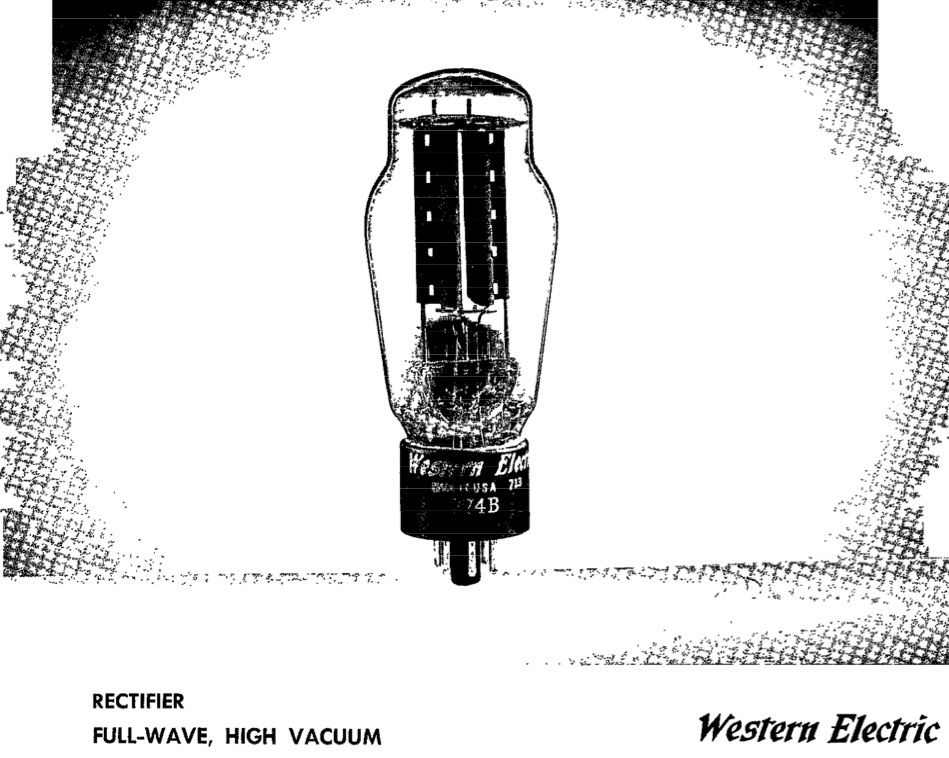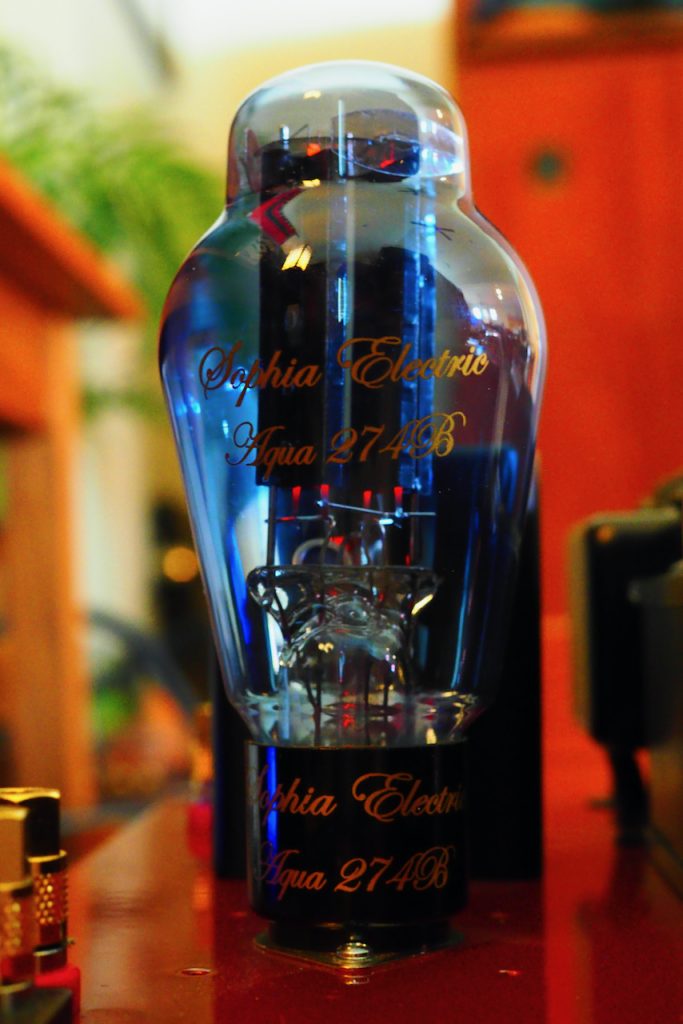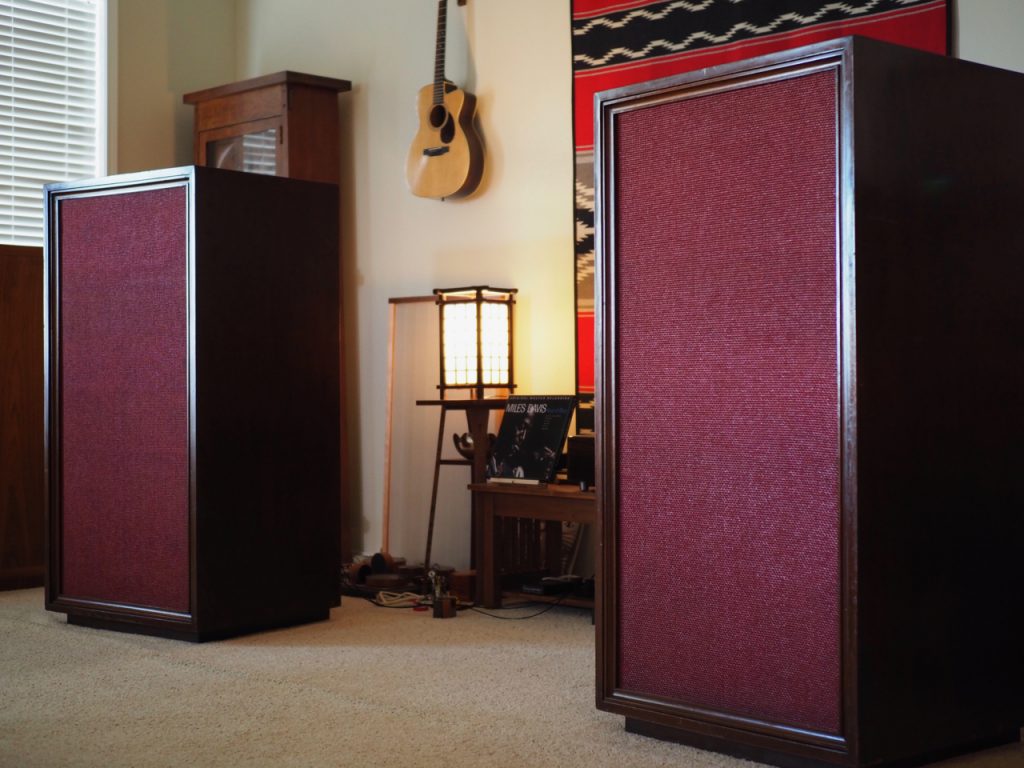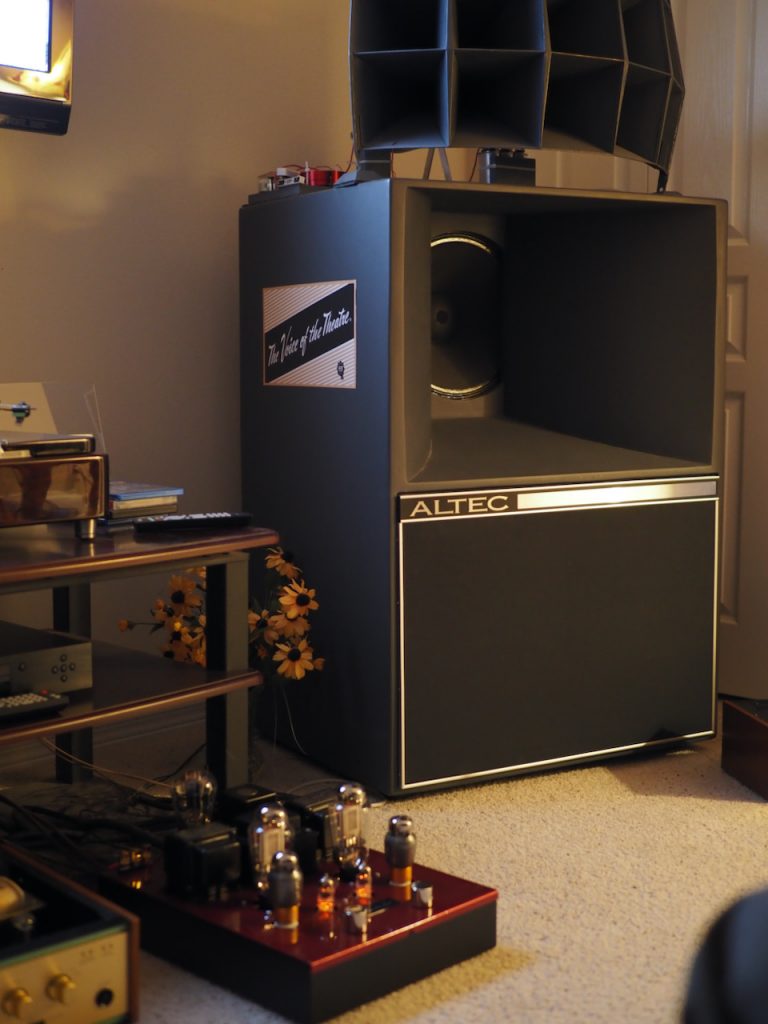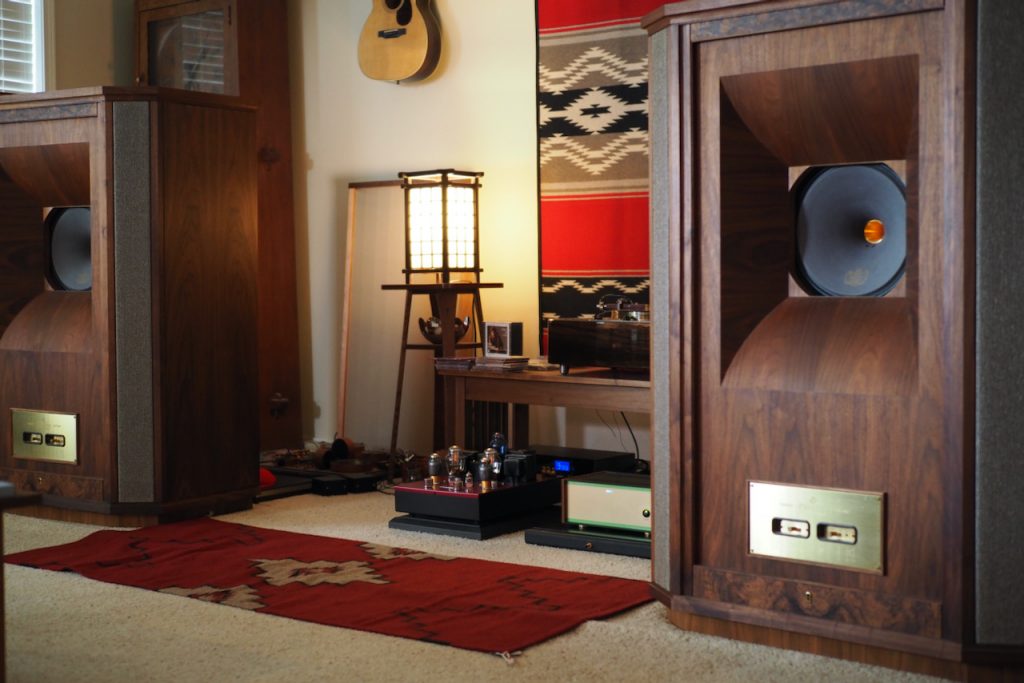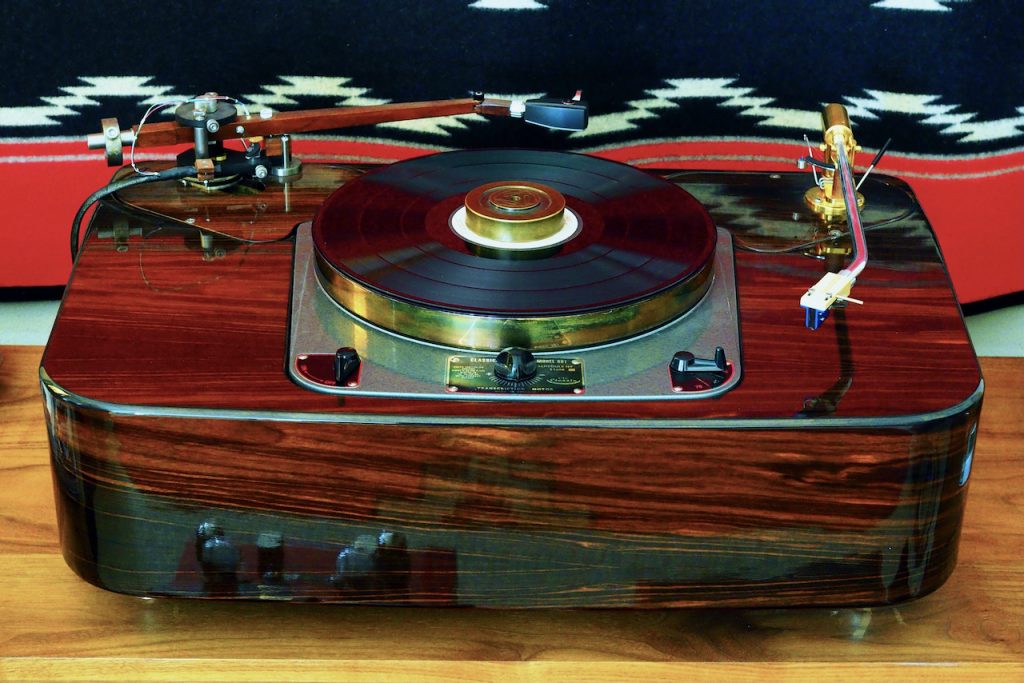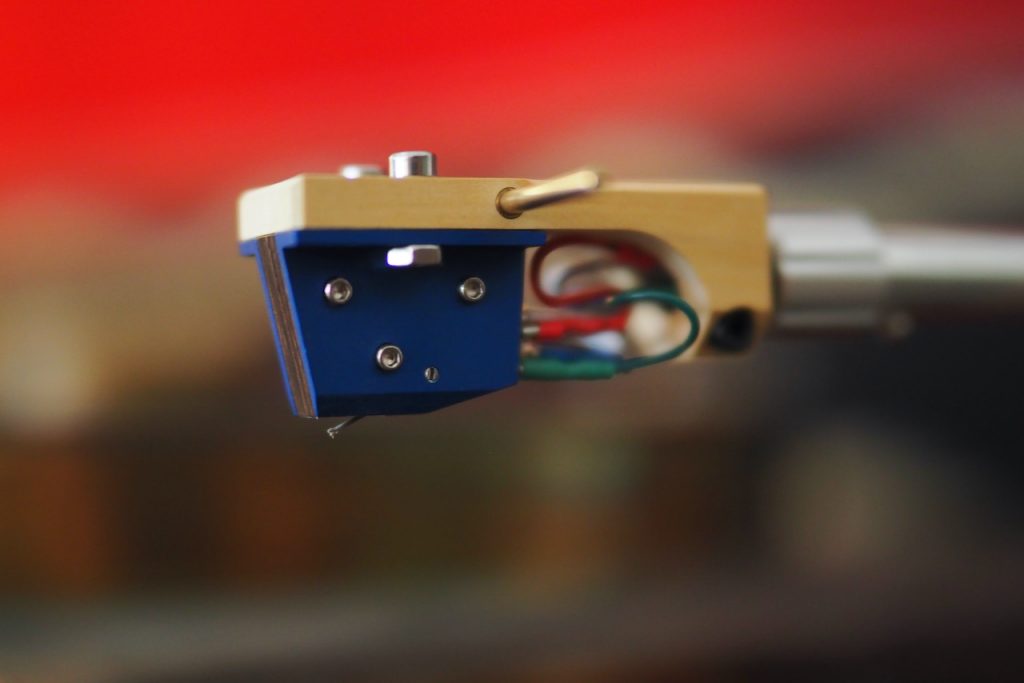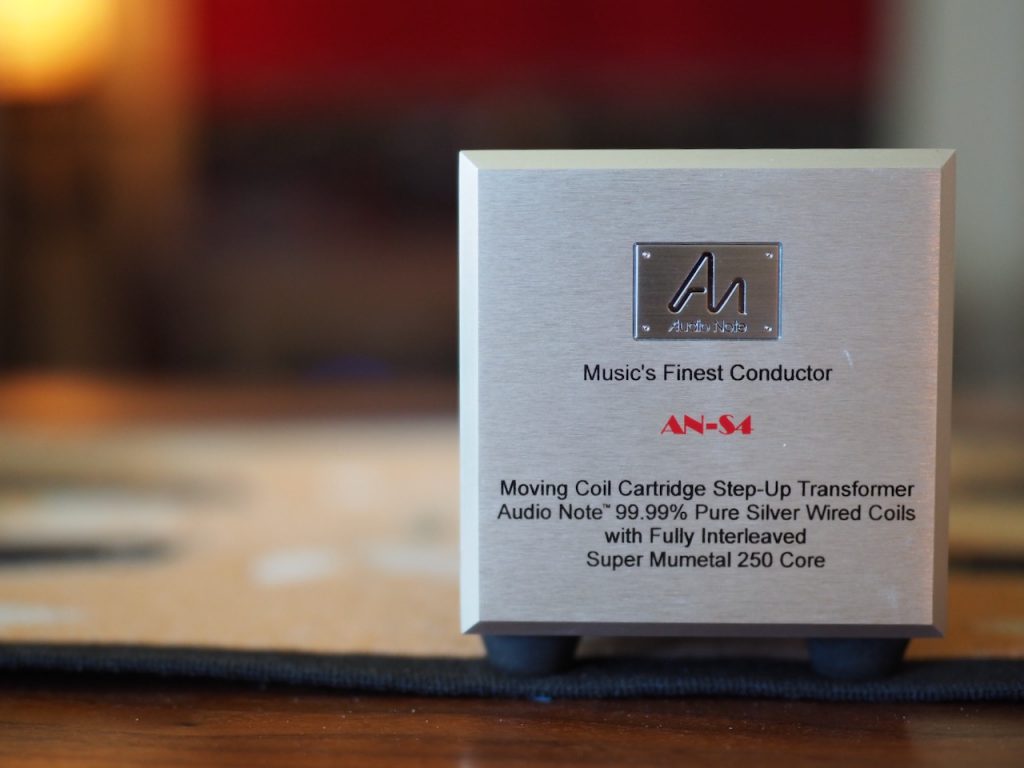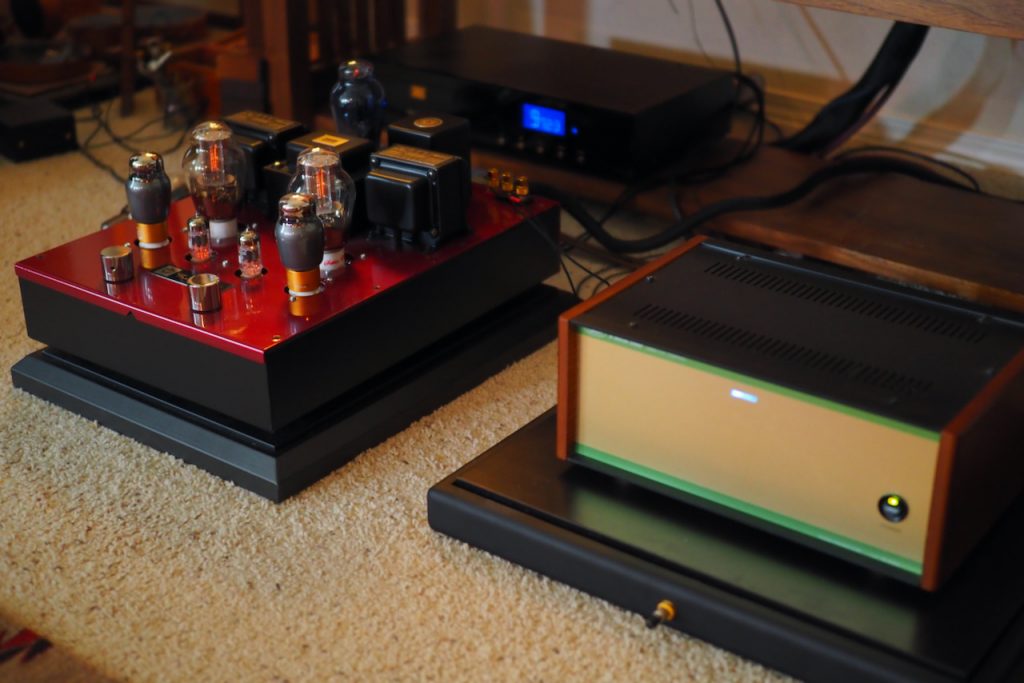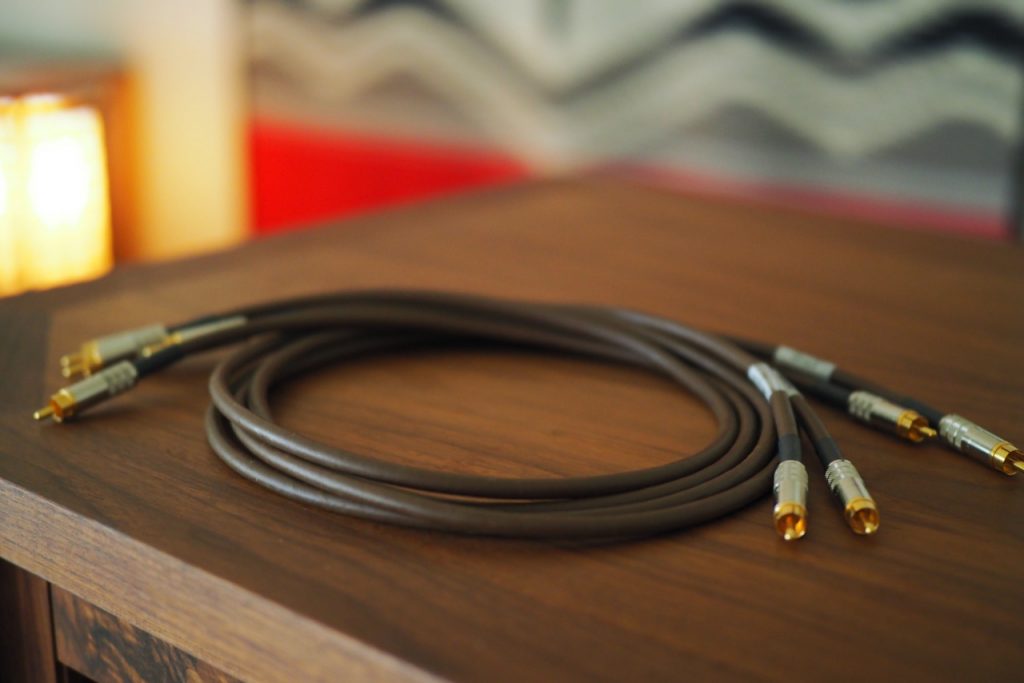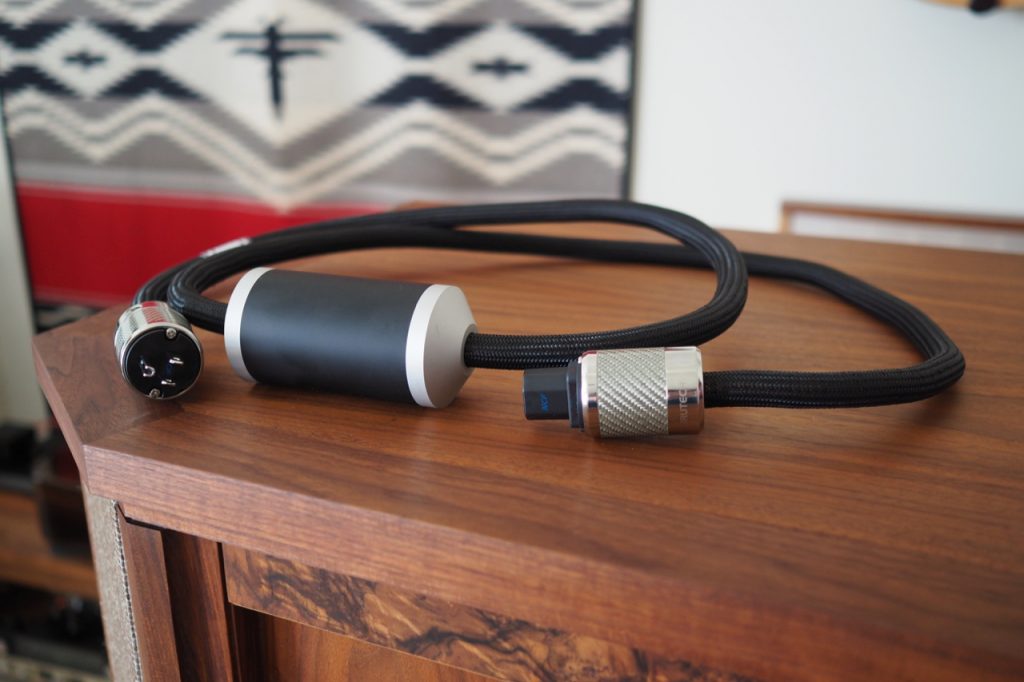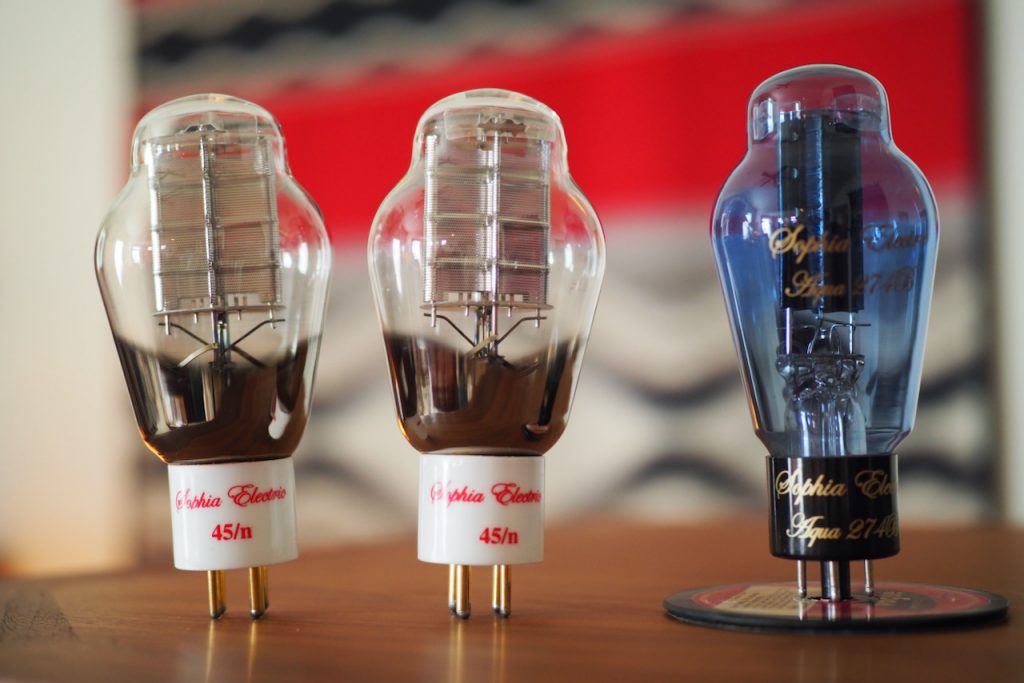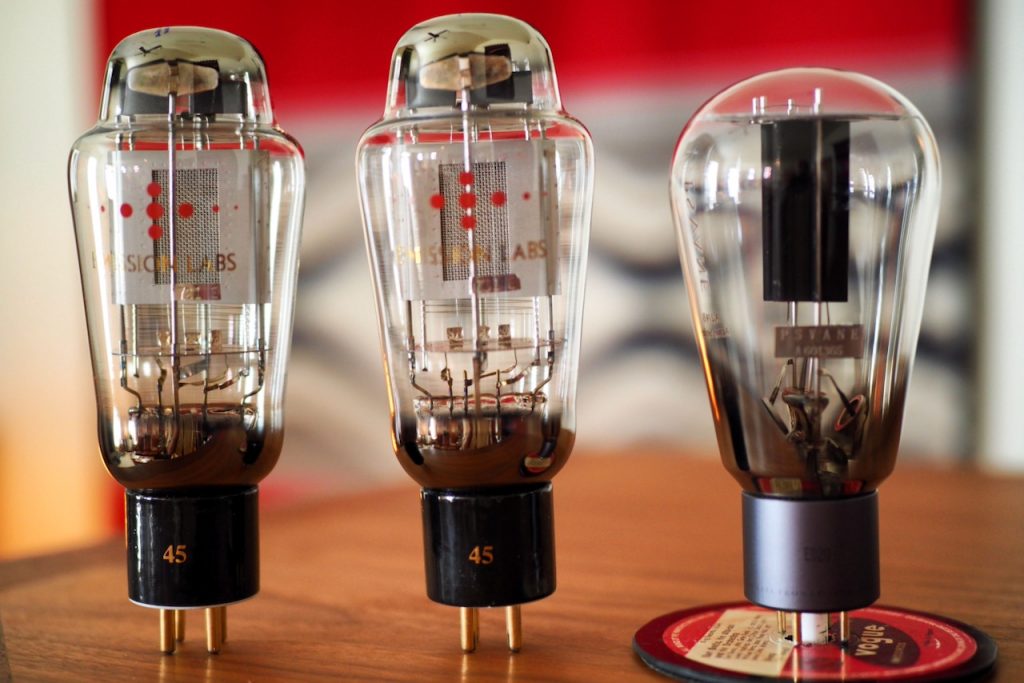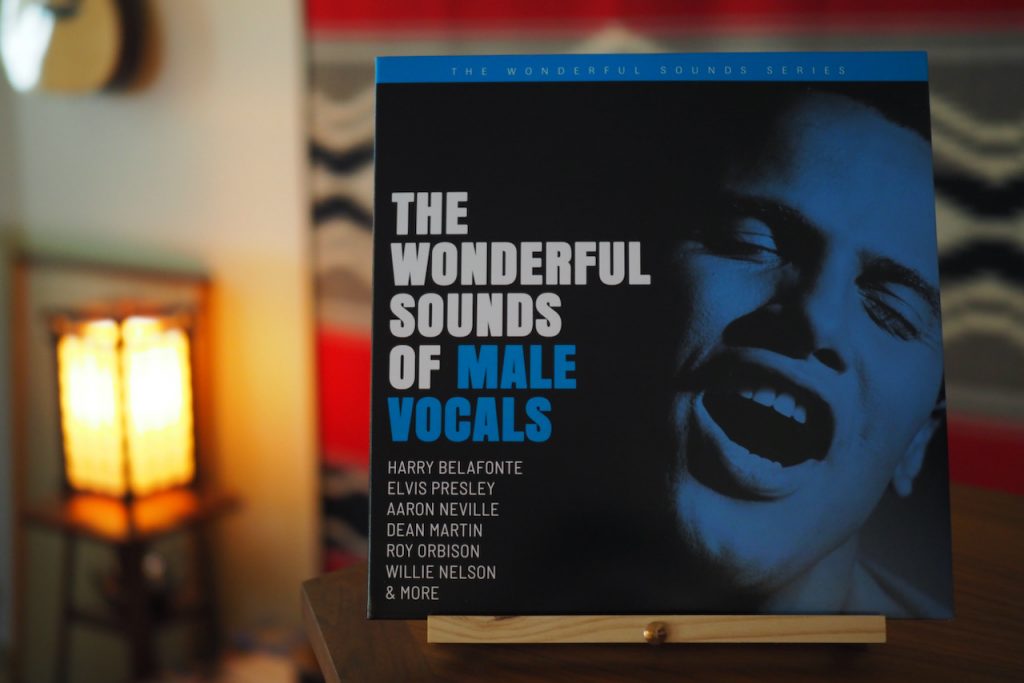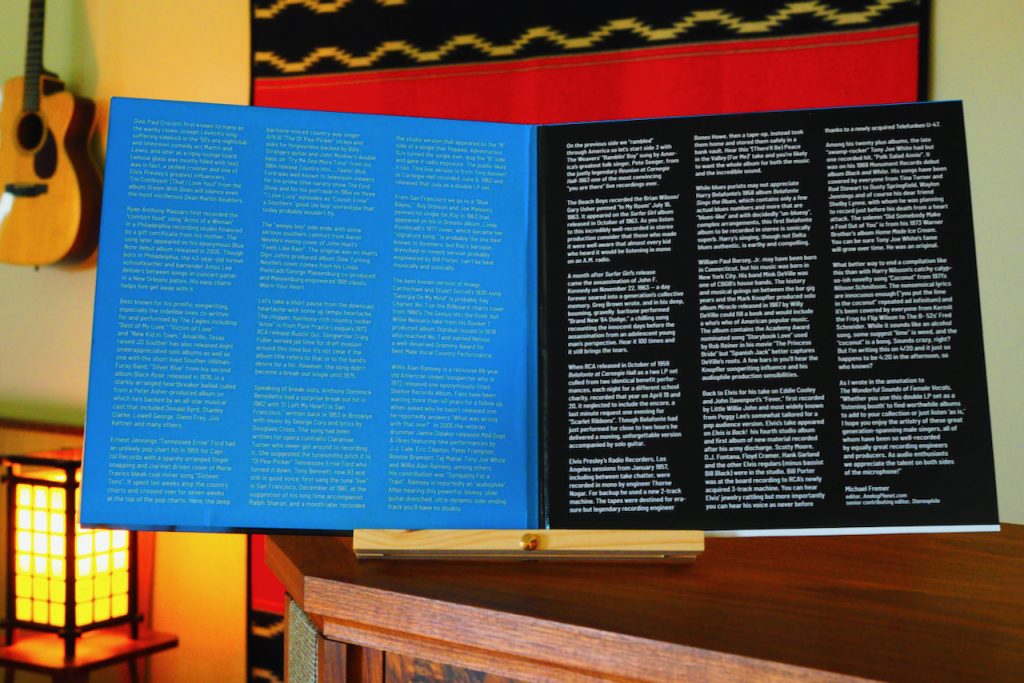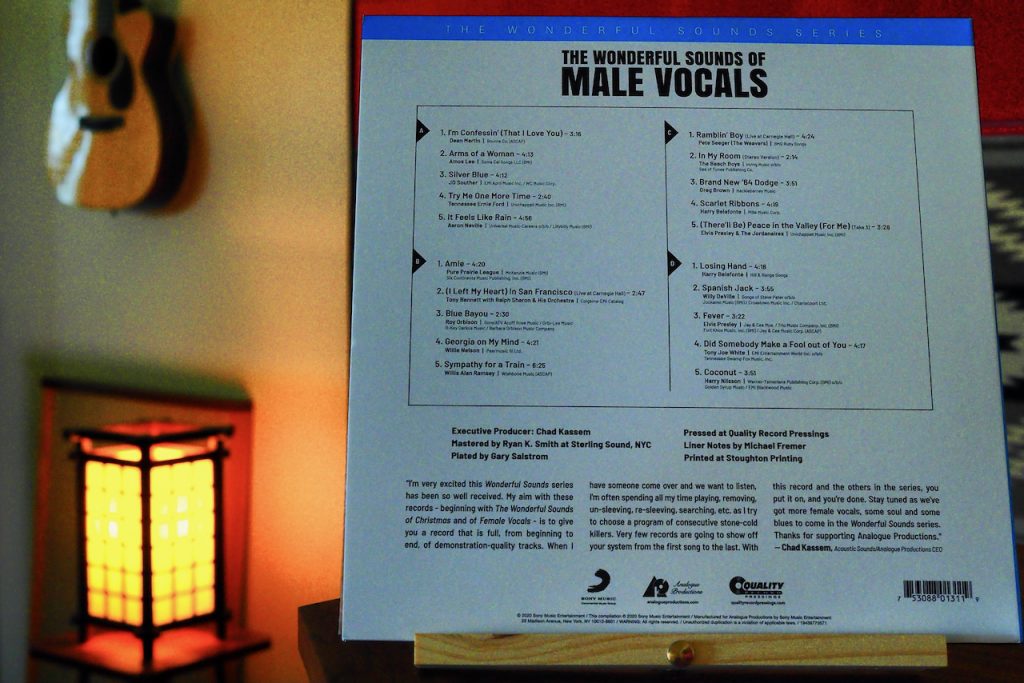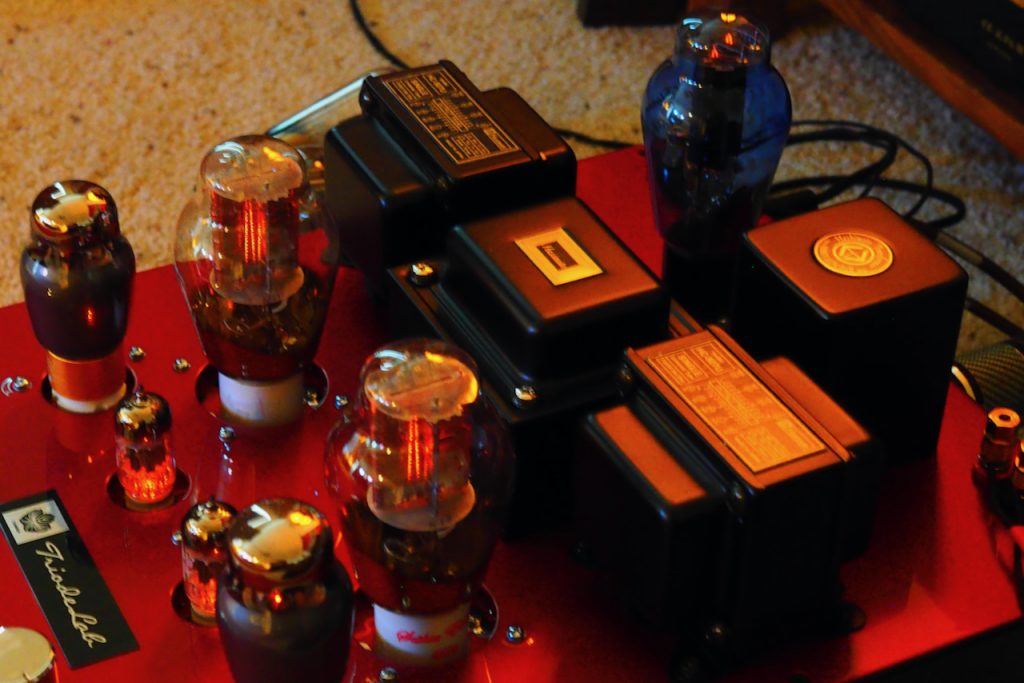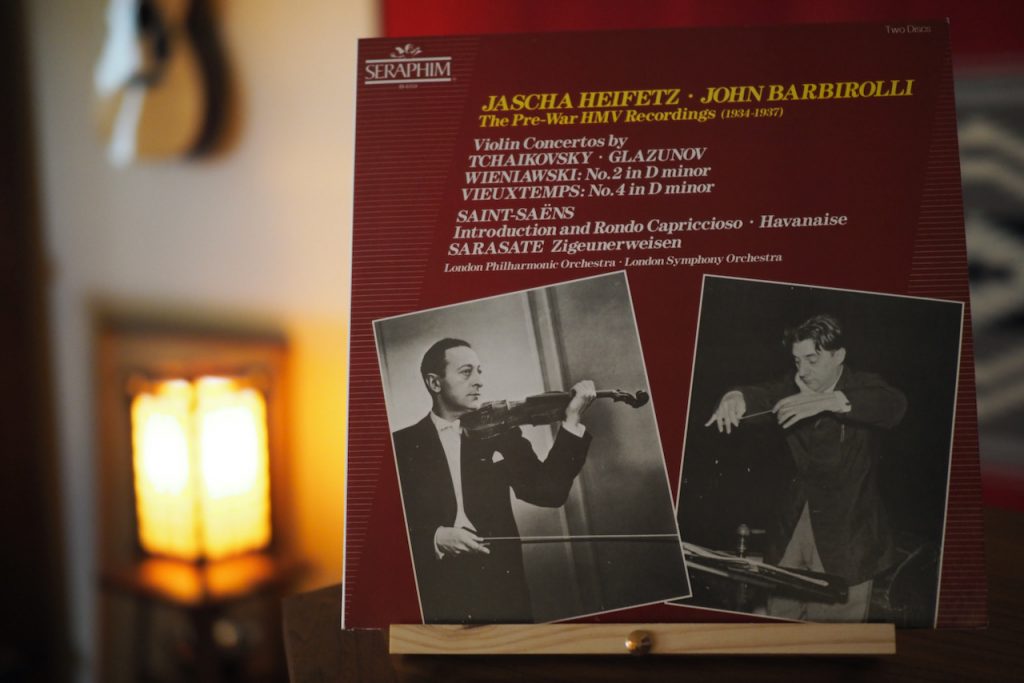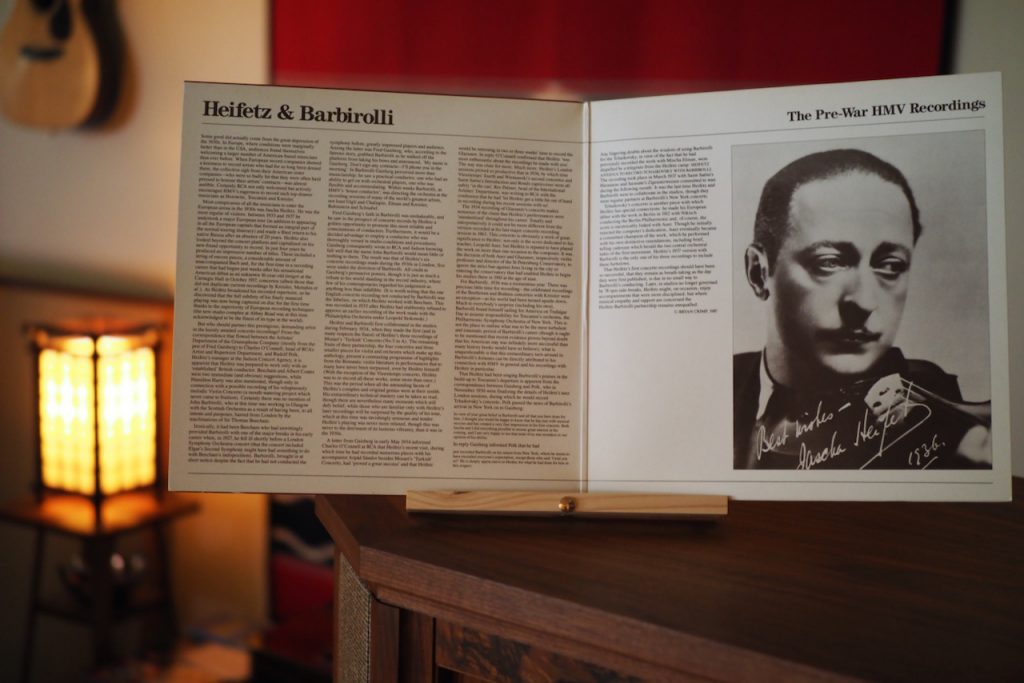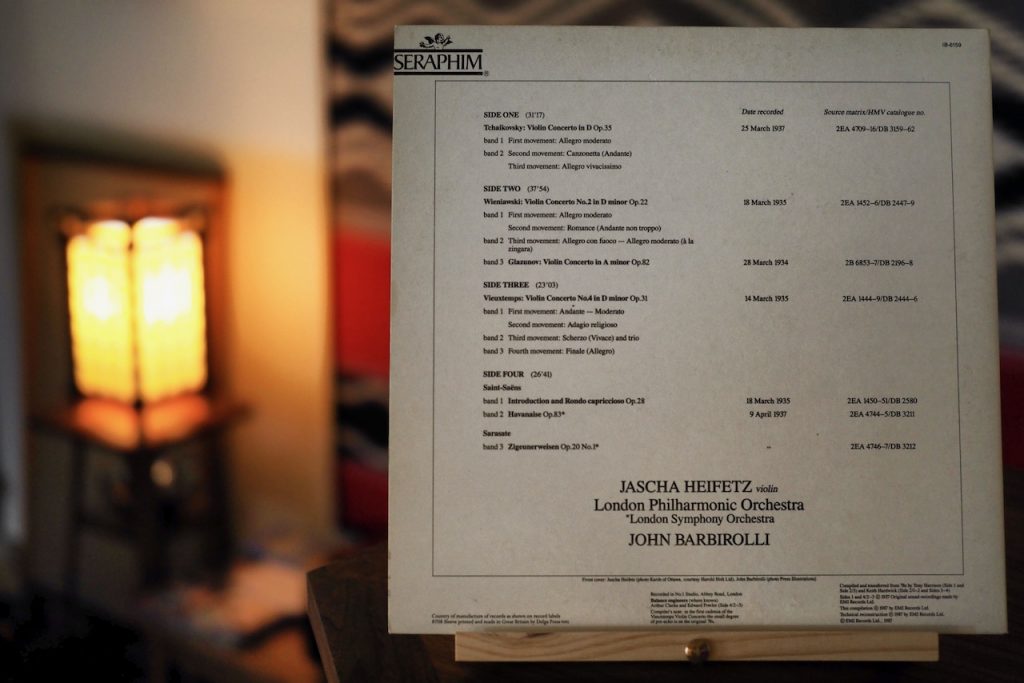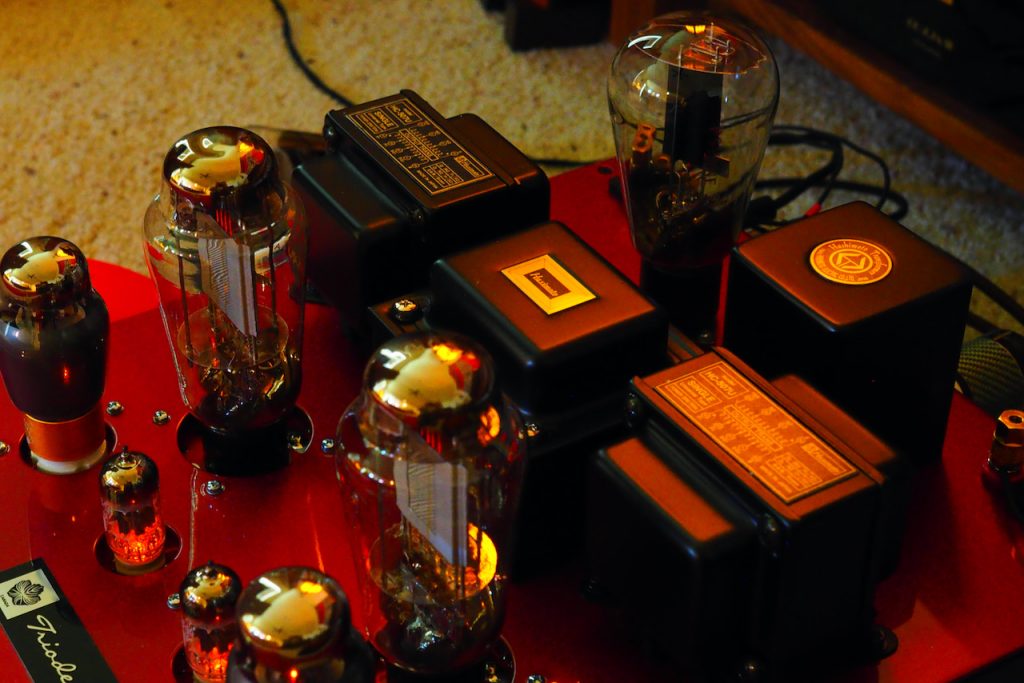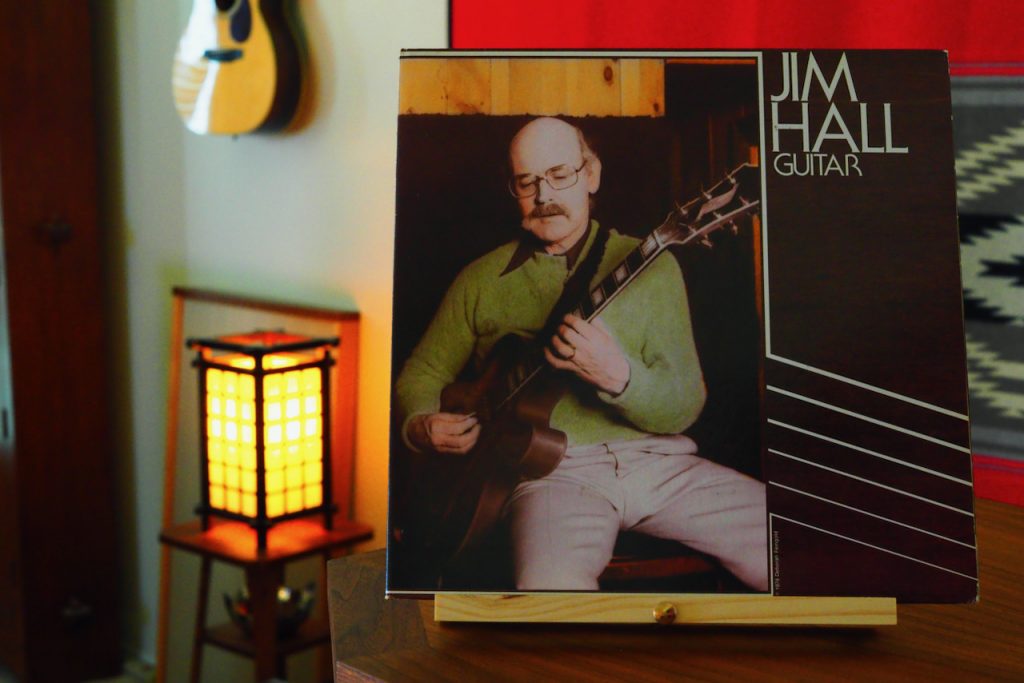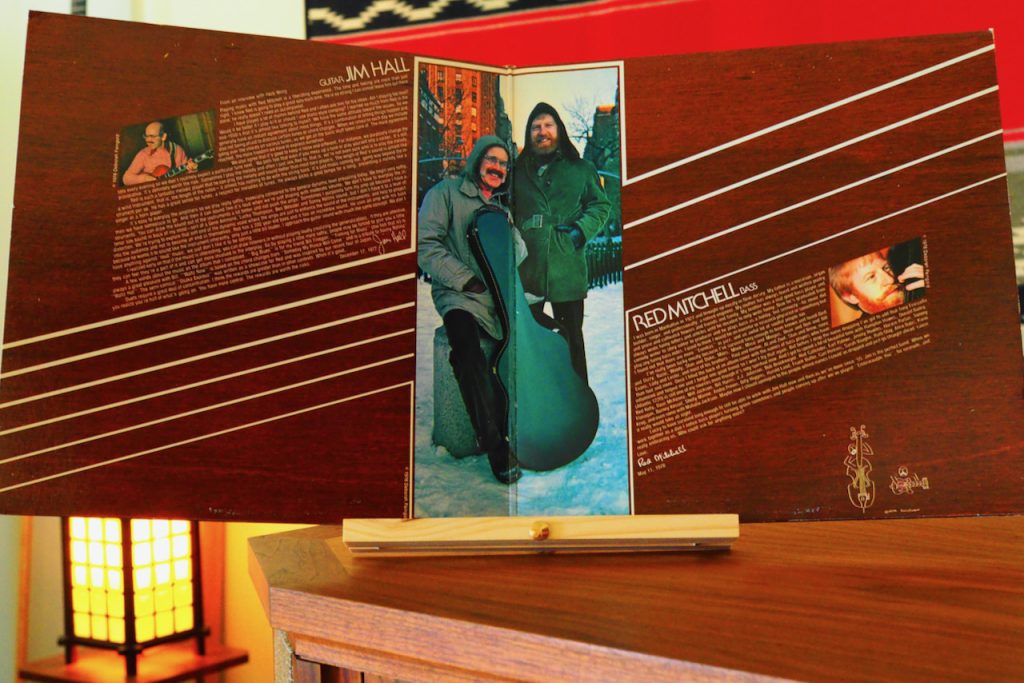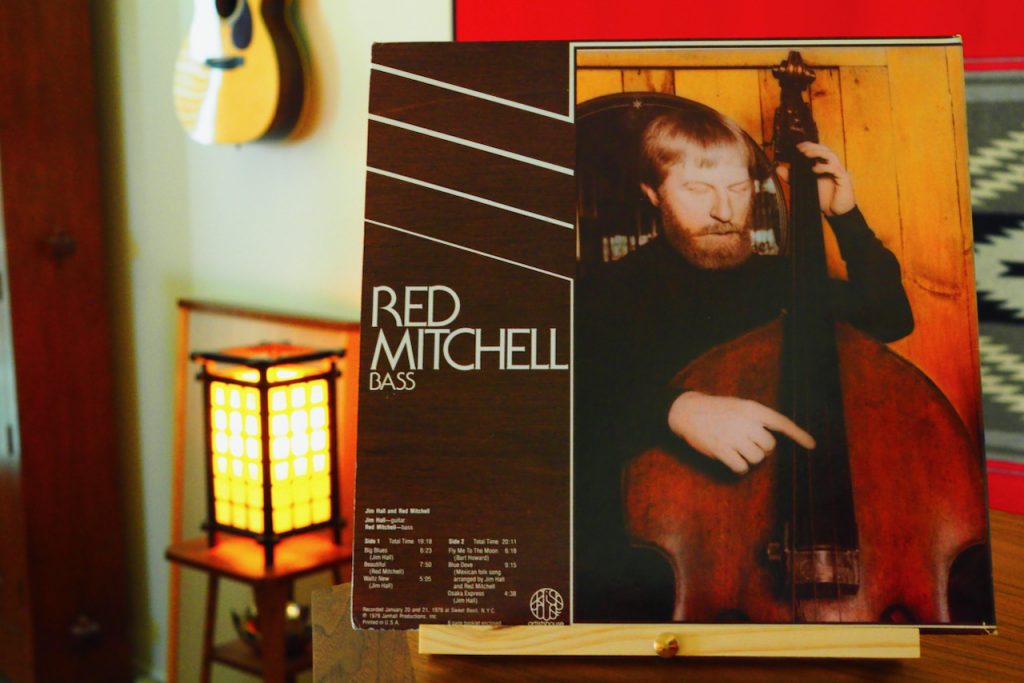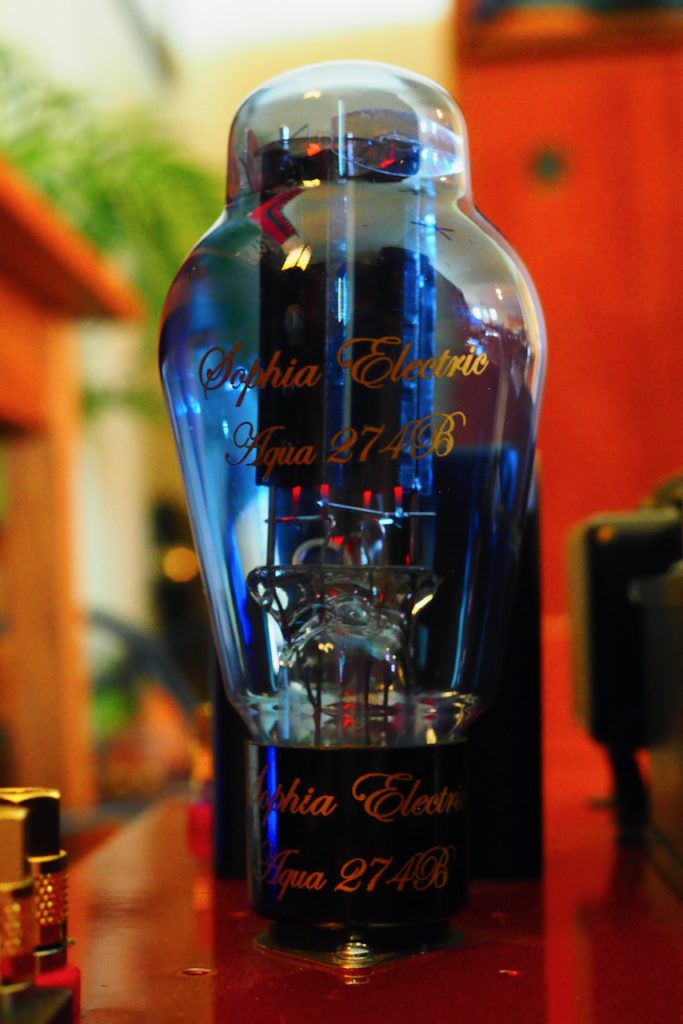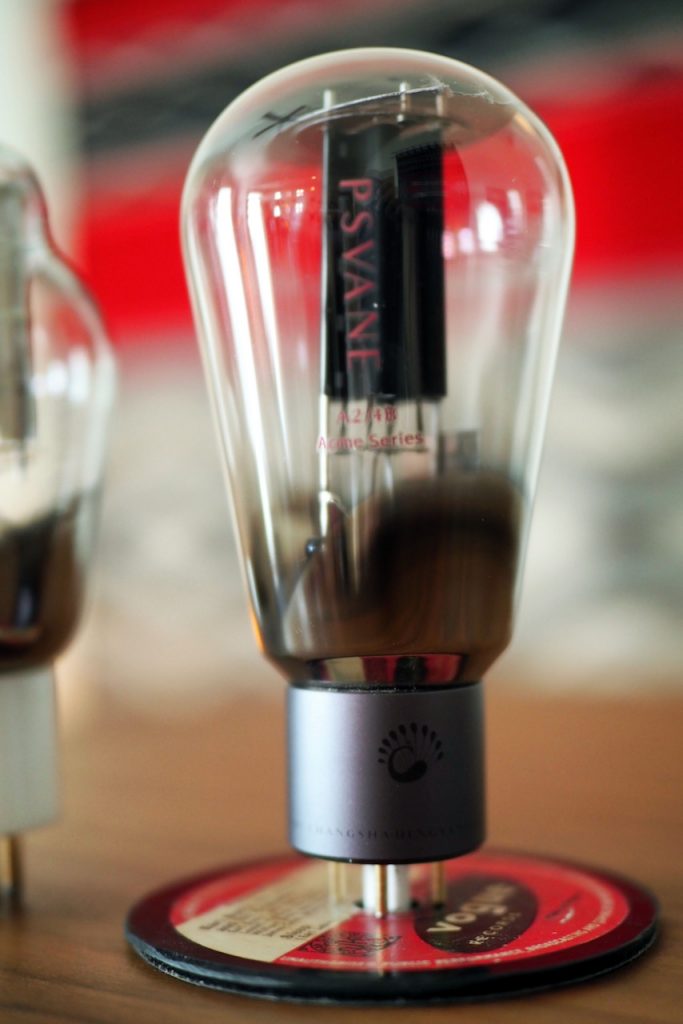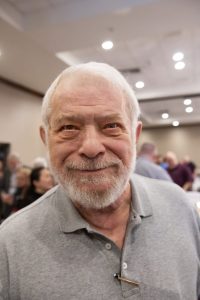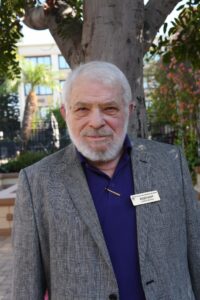A friend of mine was looking at these Sophia Electric vacuum tubes, and she told me "They're so pretty, they look like works of art."
These Sophia Electric vacuum tubes really are works of vacuum tube art. The Sophia Electric 45 mesh plate triode (above) and Aqua 274B rectifier (below) vacuum tubes are not only artful in terms of their appearance, they really are works of audio artistry in terms of their sound quality and musicality, as well.
It has been a couple of decades ago now that Gordon Rankin (Wavelength Audio) built me a pair of 45 single ended triode (SET) monaural amplifiers. I used them to power the highly-sensitive Avantgarde Duo loudspeakers I had at the time.
I had a nice selection of different brands of new old stock (NOS) 45 vacuum tubes back then, and in those days 45 vacuum tubes were still plentiful and relatively inexpensive.
Those NOS 45 vacuum tubes sounded great, with each brand having a little different mix of sound quality and musicality traits that made them fun to listen to when it came time to engage in some vacuum tube swapping adventures.
Those NOS 45 vacuum tubes had a clean, clear, and nuanced presentation that was very impressive, and yet they still managed to sound musically natural with all their abundant clarity, which was the 'calling card' of 45 triodes.
The arrival of the beautiful Triode Lab 45 EVO SET integrated amplifier from Frank Ng in Toronto got me to thinking about 45 vacuum tubes again (above).
Frank really knows how to make a superb 45 SET amplifier, and my feature article about it will be coming to Positive Feedback in the very near future.
It has been a long time since I looked for NOS 45 triode tubes that were for sale. I thought I would peruse two of my favorite vacuum tube providers websites, who usually stock a large selection of NOS valves, to see what the current situation was for 45s.
One provider didn't have any NOS 45 triodes available at all, but the other had a few, with a qualifying statement of "These tubes are very old and normally in short supply."
There are still some NOS 45 triodes for sale out there, on eBay for example, but they are a lot harder to come by than they used to be.
At this time point in time I'd say that NOS 45 triodes are on the "endangered species" vacuum tube list.
You can also add NOS Western Electric 274B rectifiers to the endangered species vacuum tube list.
I've never had the pleasure to hear the legendary Western Electric 274B rectifiers in my own home, but I've been told they're really wonderful by friends that are fortunate enough to have them.
Out of curiosity, I went out to the Brent Jesse Recording website, and there's a few NOS Western Electric 274B rectifiers available. Hang onto your wallet, as single WE 274B rectifier tubes go for $1500 to $1700 USD these days. Gasp!
Of all the rectifiers I've tried over the decades, the 274B rectifier is my favorite by leaps and bounds. If your amplifier can accommodate 274B rectifiers, your really should give them a try. You won't regret it. In fact, it just might be one of those audio life-changing moments for you, just like it was for me when I put the Sophia Electric Aqua 274B rectifiers in my vintage McIntosh MC30 monaural amplifiers.
To be clear, all is not lost for those who want 45 triodes and 274B rectifiers for their amplifiers today, as both the 45 triode and 274B rectifier are considered important vacuum tubes in the present day audio community, and there are high-quality current production versions available.
For example, in addition to the Sophia Electric 45 mesh plate triode ($425 USD per pair), Emission Labs offers 45 triode versions with a solid plate ($520 USD per pair), a mesh plate ($600 USD per pair), a higher-powered 45 triode ($590 USD per pair), and a 45 mesh plate with a globe glass enclosure ($900 USD per pair).
There may be other high-quality new production 45 triodes out there, but those are the ones I'm aware of.
For current production high-quality 274B rectifiers, there's the Sophia Electric Aqua 274B ($170 USD each), the Sophia Electric 274B mesh plate ($200 USD each), the Emission Labs 274B ($300 USD each), the Psvane Acme 274B ($290 USD each), and the Takatsuki Electric TA-274B ($1000 USD each).
That's really good news for 45 and 274B devotees, as you'll be able to keep your amplifiers supplied with new high-quality vacuum tubes in the years to come.
Hint: I recommend you stock up on some extra vacuum tubes, as you never know what kind of hand the future will deal you when it comes to vacuum tubes. It is a good idea to have a few sets stashed away should world political tensions limit the export / import of vacuum tubes, or sources of NOS vacuum tubes run dry. More than one person has contacted me concerned about the lack of availability of one or another type of vacuum tubes that their audio electronics require. It is a tough situation to be in.
In this article I want to tell you about the current production Sophia Electric 45 mesh plate triodes and the Sophia Electric Aqua 274B rectifier (above), which I'll be comparing to the Emission Labs 45 mesh plate triodes and the Psvane Acme 274B rectifier, that came in the Triode Lab 45 EVO SET integrated amplifier (below).
Before I go into the performance of these 45 triodes and 274B rectifiers, let me provide you a little more background about the Sophia Electric 45 mesh plate triodes and the Sophia Electric Aqua 274B rectifier, courtesy of Richard Wugang of Sophia Electric.
Sophia Electric 45 Mesh Plate Triode
Richard Wugang knows a wealth of information about vacuum tubes, so I asked Richard if he would share some of his knowledge about 45 triodes with us for this article, and how his Sophia Electric 45 mesh plate triode compares to the vintage RCA 45 triode as a reference point. From Richard:
"First, let's figure out the timeline. Before we arrived in this digital age with silicon chip amplifications, we were in analog chip amplifications (1980s to 1990s). Prior to that was the discreet transistor age (late 1950s to 1970s) and the vacuum tube era (1920s to 1950s). During the 1920s to 1950s, we used vacuum tube for almost everything tech related. The center piece of technology was vacuum tubes, much like silicon chips we have today.
"So, what is a vacuum tube? Who invented it then?
Thomas Edison. Public domain photo courtesy of Wikipedia.
"Before the vacuum tube's debut, Thomas Edison laid the groundwork with his light bulb, more specifically the hot filament that would emit out electrons towards a metal plate in the vacuum
state. However, Thomas Edison was more interested in the proportion of the electrons; in other words, the sensitivity rather than amplification, detection, or rectification that vacuum tubes later relied on.
1879 Edison light bulb. Photo courtesy of Wikipedia GNU Free Documentation License.
"In 1904, John Ambrose Fleming discovered the one directional character of the Edison light bulb experiment, paving the way for a new vacuum tube device known as a diode. Diodes soon found their way to be used in trans-Atlantic shipping wireless reception to replace the older cat whisker crystal radio detector.
John Ambrose Fleming. Public domain photo courtesy of Wikipedia.
"In 1906, Lee de Forest invented the Audion tube—later on called the triode. It was an improvement on the 'Fleming Valve' tube which was a diode. At this time, the vacuum tube had gained its ability to have gain in amplification.
Photo by Gregory F. Maxwell, uploaded to Wikipedia for use under the GNU Free Documentation License.
"Early tubes used the filament as the cathode; this is called a "directly heated" tube. Direct heated tubes have their advantages as they had simple, higher efficiency compared to the later indirected tubes that debuted in the 1910s.
A side note: the later 45 tube, 2A3 tube and 300B tubes are all direct heated tubes, while EL34 and KT88 are indirect heated tubes.
"GE, WE and RCA are among the earliest companies that put tubes into commercial production. At the time, the initial vacuum tube technology was considered high technology and was super expensive. The RCA company sold about 1.25 million receiving valves or tubes in 1922, but by 1924 this has risen to 11.35 million, showing the tremendous growth and popularity nonetheless.
"I have access to two of the earliest RCA tube publications. The receiving tube manual published in late 1920s had all the early tubes in the order of numbering from 001A to number 80. Below is a typical RCA tube manual sheet.
"The 45 tube is a direct heated power triode tube. The early 45 tube versions were called the UX245 or CX345, and belongs to one of the early vacuum tube models from the 1920's.
"For reference, the more commonly seen audiophile 300B tubes first debuted in 1930s as the Western Electric 300A.
"The earliest RCA 2A3 of late 1920s was basically two 45 tubes built into one glass tube in a parallel connection. The single plate RCA 2A3 has a double plate size compared to their 45 tube.
"The basic characteristic of a 45 tube is that this tube can be heated by DC or AC at 2.5V with filament current of 1.5A by applying 250V or 275V max at plate and biasing at -50 to -56 volts. It would allow a plate current of 34-36ma with a plate load (transformer) of 4-5K ohm to output 1.6-2W of power.
"In a two tubes push-pull circuit in class B operation mode, the power can be multiple times higher of the Class A single ended circuit. It may sound like flea power today; however, it was earthshaking high power in the early days of tube amplification.
"Western Electric, years later, would power an entire cinema with only a mono 5W from a single ended 300B tube amplifier. (Stereo was not invented just yet as the stereo only became possible in the mid-1950s).
"Compared to the tubes on the market, namely tube model 10 and 171A (now known as the 71A today), when the 45 tube debuted, the 45 tube excelled in greater efficiency to deliver more power with about similar plate voltage. My father DWU and I got to know the 45 tube through servicing Victor high end radio console tube radio amplifiers.
"Side-note: That Victor amplifier still shows up on auction sites from time to time. However, do not jump on it. Even though you can restore it to make it work, the output transformers from the 1920's surely have a very limited bandwidth because the source of music back then would only extend to 6K or so, as if from old telephones or acoustic gramophones, much worse than the sonics from postwar AM radio 2-3 decades later.
"Why the 45 tube?
"For the very modest power output, the 45 would have been forgotten. However, one outstanding strength has made audiophiles rediscover it decades later. The sound from the 45 triode tube is simply pure, seductive, and even magical! Anything good that can be said about 300B tube, well, the 45 can do better, with only one limitation of its 2W output, versus 3.5-4W from the 2A3, and 8W from a single-ended 300B.
"If you have speakers efficient enough to utilize 2W of power output, then you can forget about any other fancy tube. However, 99% of us can't, and thus the 300B still rules the land of tube audio with four times more power and dynamic headroom than a smaller 45 tube.
"As a result, the little humble 45 tube joined the rank of direct heated triode bandwagon to be known once again in 1990s. Sophia Electric had many prototype amps and custom amps utilizing the 45 as a driver tube to drive more powerful tubes such as the 300B, 845, and 212."
Note: Most of the current production 45 tubes offered for sale today are referred to as being electrically equivalent to the RCA 45 tubes of yesteryear. The RCA 45 triode is "the 45 triode" whose history still influences the current production 45 triodes, just as the Western Electric 300B triode is "the 300B triode" that still influences the current production 300B triodes. Note also that current production 45s, while being electrically equivalent to the RCA 45, doesn't mean they sound the same, and they don't. - Jeff
"The biggest difference between Sophia Electric 45 tubes and vintage RCA 45 tubes:
"The vintage RCA 45 vacuum tubes evolved little by little from earlier power tube designs. The 01A to the 10 to the 71A before the 45 tube design arrived. There were many incremental patches and stretches from a smaller power tube design.
"Thus vintage 45 tubes, even though they sounded very good, do show limitations in their design and actual sonic performance. There is not much extra power margin when you need extra power and dynamics.
"Remember that the 45 tube was designed in the 1920s and then got popular in early 1930s, during a period of time when sonic reproduction was for 6,000 Hz in AM and cinema dialog. Western Electric pushed for a 10,000 Hz bandwidth when their 300B tube debuted.
"10,000 Hz bandwidth sounds like the medieval dark age by today's frequency standards, let alone the 6000 Hz in the 1920s when the 45 triode debuted.
"After many decades of technology advancement in vacuum tubes, Sophia Electric added mesh plates to its vacuum tube designs in the early 2000s: the 300B, 45, 2A3, 845, 101D, 205D, etc.
"In contrast to the vintage 45 vacuum tubes, our Sophia Electric 45 mesh plate triode progressed from a small power tube to a slightly larger one (photo below).
Note: For the sake of comparison, the original RCA 45 triode was 4 11/16 inches in height and 1 13/16 inches in width, with a ST-14 glass bulb size, where the Western Electric 300B triode was 6 1/2 inches in height and 2 7/16 inches in width, with a ST-19 glass bulb size. The Sophia Electric 45 mesh plate triode measures 5 11/16 inches in height and 2 7/16 inches in width. - Jeff
"The Sophia Electric 45 mesh plate triode was a result of many decades of knowledge. It is a new design from the ground up without considering using earlier tube tooling, which was a cost consideration for vintage tubes.
"The actual Sophia Electric 45 mesh plate triode started from a scaled down 300B tube design and tube structure, and uses exotic materials that were unknown to vintage tube designers.
"I found the 300B mesh plate tube to sound more natural, and have more extended highs and lows than the rigid plate 300B. As a result the 300B mesh plate tube gained far more demand than the rigid plate version. Our Sophia Electric 45 tube was introduced after the 300B mesh plate tube, so we introduced the 45 with a mesh plate instead of a solid plate for the same benefits of naturalness, and more extended highs and lows, like we realized with the 300B mesh plate.
"Thus even though the Sophia Electric 45 tubes have the same electrical characteristics as its vintage 45 cousin, they do have extra power dissipation with more high frequency and bass extension. It is a bigger tube design with vintage 45 DNA inside. Sophia Electric 45 tubes sound bigger, deliver more natural and more refined sound at even lower distortion when operating at the maximum power output.
"The Sophia Electric 45 tube was designed and made decades later, armed with new knowledge, new materials, new manufacturing methods, and with audiophile sonic requirements in mind. As a result, it is no surprise that the Sophia Electric 45 mesh plate sounds better than vintage 45 tube from RCA and many other vintage brands."
Sophia Electric Aqua 274B Rectifier
I first wrote about the Sophia Electric Aqua 274B rectifier in Issue 93 of Positive Feedback (HERE).
The Sophia Electric Aqua 274B rectifiers were a revelation in performance for my vintage McIntosh MC30 monaural amplifiers, and as a result I've been using that same pair ever since I wrote the article in 2017. They've got lots of hours on them and are still going strong.
I've included snippets of Richard's description of the Sophia Electric Aqua 274B rectifier from that article for additional context in this article:
The original 274B rectifier tube was developed by the legendary Western Electric company in America. The Western Electric 274B is filamentary full-wave rectifier with an octal base that delivers direct current from an alternating current source. You can read the full specifications of the WE274B HERE, in the Western Electric Vacuum Tube Data Manual (1941).
I asked Richard if he would tell us about his Sophia Electric Aqua 274B rectifier tube, and how it compares to the original Western Electric 274B rectifier tube.
"Prior to Aqua 274B rectifier tube, Sophia Electric has made a number of successful 274B rectifier tubes, like the Princess 274B mesh plate, which we consider "the ultimate choice" for today's high-end tube pre-amplifiers and headphone amplifiers, as well as for small triode (2A3/45/PX4/71A/205D/101D) tube mono-block amplifiers.
"Our Princess 274B rigid plate rectifier tube is a true replica of the vintage Western Electric 274B rectifier tube. Many audiophile users have reported that it sounds better than the original vintage Western Electric 274B in the WE91 300B circuit, or in a modern 300B single-ended tube amplifier circuit, and at a fraction of the cost.
"However, all traditional 274B rectifier designs (Sophia or Western Electric) have the limitation that the first capacitor in the power supply after the rectifier tube must be miniscule. For vintage Western Electric 274B rectifier tubes it can be no bigger than 4 uF, and for the Sophia Electric rigid plate and mesh plate 274B's the limit is a slightly higher 8 uF. No matter how great those 274B tubes sound, this capacitor requirement limits 274B applications, just as it did for the original Western Electric 274B rectifier during the golden age of vintage vacuum tubes. Mainstream rectifier tubes like the 5U4 (America) and 5AR4 (Europe) permit up to 47 uF in the first capacitor position in a power supply, making them applicable to a wider variety of power supply designs.
"So why bother with a 274B rectifier? Back in the early 1930s Western Electric designed the WE91 cinema amplifiers that utilized the 300B tube in a single ended output circuit. The WE91 produced an output of 5.6W, which was enough to drive the cinema horn loudspeakers of the 1930's to volume levels adequate for cinema sound reproduction. 300B tubes require about 60V RMS drive voltage to achieve their full output power of 5.6W. To accomplish this, Western Electric chose the 310A, a pentode tube, for their driver choice.
"The pentode driver tube was an elegant choice, but it was at the expense of high frequency extension. Back then, 10KHz was considered the maximum high-frequency for high-fidelity, with movie dialog being more in the mid-range. Even so, Western Electric still wished for a little more high-frequency extension in their WE91 300B amplifier to make the sound more open and lively. This demand called for a premium long plate rectifier tube, now known as the WE 274B tube.
"Without the 274B rectifier tubes, Western Electric tube amplifiers sounded rather dark and dull. But with the 274B, Western Electric amplifiers sounded full and complete, and the 274B was a significant sonic upgrade.
"However, when the power supply capacitor is higher than 8 uF the long plate of the WE274B sparks, which forced Western Electric to limit the design requirement to 4 uF. This limitation prevented the 274B rectifier tubes from being used in a wide variety of applications, both in vintage times and today, as most modern equipment was designed with up to 47 uF capacitors as the first capacitor in the power supply so they could utilize 5U4G and 5AR4 rectifiers.
"Sophia Electric has solved this limitation of the 274B in our Aqua 274B rectifier tube (above). Initially we tried to solve this limitation by using exotic materials, as in the design of our very popular Royal Princess 300B tubes, which utilizes platinum and rare earth materials. We were successful, but the finished product was way too expensive for the average consumer to be viable.
"Then we went back to the WE 274B structure design as a starting point, and in an unexpected way we figured out a way to solve the Western Electric limitation of 4uF. This solution allowed us to build the Sophia Electric Aqua 274B, which can use up to a 47 uF filter capacitor value, the same maximum value permitted for 5U4 and 5AR4 rectifiers."
"In a 300B mono-block amplifier, such as Sophia Electric's 91-01, or the newer 91-01 Signature amplifier, the Aqua 274B can easily replace the 5U4 rectifier tube and deliver a wider and deeper soundstage, and deliver the musical magic that is otherwise missing when not using a 274B rectifier."
One of the first things you'll notice when you look at Sophia Electric Aqua 274B rectifier is its blue-tinted glass bulb. I asked Richard if he would tell us about the reason for that blue tint.
"The blue tint that we've added to the glass not only looks exotic, but during the voicing process we found that the blue tint of the ST shaped enclosure added more sonic impact to the presentation of the music.
"Vintage US military tubes often had a black metal base and/or black-grayish smoky carbon-containing paint sprayed on the inside of the glass tubes for light shielding to reduce noise. British and German military tubes often used red paint for light shielding to reduce noise.
"We have auditioned various light shielding possibilities, and ultimately settled on the blue tinted glass, which when combined with ST bottle shape, provided additional musicality and a distinctly better tone.
"Back when all vacuum tubes were placed inside a chassis, there was no need for consideration about light induced noise. However, high-performance audio enthusiasts now like to see the tubes displayed in the open, so they can see them from their listening seats, and they also enjoy seeing the glow of the filaments.
"The blue tint ST bottle shape is an ideal solution, as it is a beautiful and excellent sounding bottle shape, and the blue tint offers the benefit of a reduction in light induced noise, while still allowing the listener to see the beautiful glow of the filaments."
Review Systems
I've listened to the Triode Lab 45 EVO single-ended-triode (SET) integrated amplifier with the Sophia Electric 45 mesh plate triodes, Sophia Electric Aqua 274B rectifier, Emission Labs 45 mesh plate triodes, and the Psvane Acme 274B rectifier in three different audio system contexts.
The first system context was with my Duelund-ized vintage "Stokowski" Altec loudspeakers (HERE) in my main music system (above), where the Triode Lab 45 EVO SET integrated amplifier provided those classic goosebumps musical experiences that the combination of highly-sensitive loudspeakers and single-ended-triode amplification seem to so easily achieve.
I then tried the Triode Lab 45 EVO SET integrated amplifier with my vintage Altec A5 Voice of the Theatre loudspeakers in my audio-visual system (below), and I again experienced that combination of highly-sensitive loudspeakers and 45 SET amplification that made watching movies or television shows an exciting, engrossing, and immersive experience.
There's something really special about that kind of video experience, and it hearkened me back to the days of my youth, when the small-town American movie theaters still used Altec A5 loudspeakers with Western Electric 91-A amplifiers.
Finally, I listened to the Triode Lab 45 EVO SET integrated amplifier in my main music system with my Duelund-ized Tannoy Westminster Royal SE loudspeakers (below), and all the listening impressions I've written below are from that system context.
For a source I used my Classic Turntable Company hot-rodded Garrard 301 in an Artisan Fidelity plinth (below).
All of my listening impressions were with my Thomas Schick tonearm mounted with an Audio Note (UK) I0 I moving-coil phonograph cartridge, which I'll be writing a Positive Feedback feature review about in the not too distant future.
If you read my review of Pass Labs XP-17 phono equalizer (HERE) you can get a preview of sorts of the performance of the Audio Note (UK) I0 I moving-coil cartridge—it is superb.
The Audio Note (UK) I0 I moving-coil phonograph cartridge was stepped up with the Audio Note (UK) AN-S4 step-up transformer (SUT)—review to come.
Phono equalization was performed by the sweet little Leben RS-30EQ, which was the best phono equalizer match to the Triode Lab 45 EVO SET integrated amplifier that I had at my disposal.
1-meter pairs of Belden 8402 microphone cable interconnects terminated with Switchcraft 3502A RCA connectors connected the Audio Note (UK) AN-S4 SUT to the Leben RS-30EQ, and the Leben RS-30EQ to the Triode Lab 45 EVO SET integrated amplifier.
As most of you know, the Belden 8402 tinned-copper microphone cable interconnects are a longtime favorite of mine, due to their superbly balanced musicality and sonic prowess (above).
As a cost effective bonus, Best-Tronics Pro Audio will build a 1-meter pair for a paltry $77.70 USD, which is a bargain in the world of high-performance interconnects. Best-Tronics is my go-to source for Belden 8402 interconnects.
Power cords for the Leben RS-30EQ and the Triode Lab 45 EVO SET integrated amplifier were Acoustic Revive 'Absolute' power cords (above).
To connect the Triode Lab 45 EVO SET integrated amplifier to my Duelund-Westminster Project (HERE) Tannoy Westminster Royal SE loudspeakers I used Duelund DCA16GA tinned-copper speaker cables.
Listening Impressions
I've been listening to the Sophia Electric 45 mesh plate directly heated triodes and the Sophia Electric Aqua 274B rectifier in the Triode Lab 45 EVO integrated SET amplifier for about five months now, and in three different system contexts, as mentioned above.
During that time I've alternated between the Sophia Electric 45 mesh plates and the Sophia Electric Aqua 274B rectifier (above), and the Emission Labs 45 mesh plates and Psvane Acme 274B rectifier (below) that were provided with the 45 EVO by Triode Lab, to get a feel for the performance of those vacuum tubes in the 45 EVO.
These new production 45 directly heated triodes were a revelation to me in their ability to drive my Tannoy Westminster Royale SE loudspeakers to live-like levels, although the Triode Labs 45 EVO integrated amplifier was running pretty close to wide-open to accomplish that, with little headroom left over.
While my Westminsters are rated at 99dB in sensitivity, in the past amplifiers with even four times the power output of the 2 watt Triode Lab 45 EVO SET integrated amplifier couldn't drive the West's so well, so I was impressed by these new production 45 mesh plates ability to drive my Westminsters.
When listening with my 100-plus dB sensitivity vintage Altec loudspeakers, these 45 mesh plates had power to spare.
I've listened to quite a lot albums over the last five months, and my general observations are that the Emission Labs 45 mesh plates and Psvane Acme 274B rectifier are warmer sounding, less transparent, and less resolving of musical nuance than the Sophia Electric 45 mesh plates and Aqua 274B rectifier.
It's been way too long for me to reliably compare in specific terms the sound of these new production 45s to the vintage 45s that I used to enjoy in my Wavelength 45 monaural amplifiers, but I think I can offer some general observations on vintage versus new production performance you might find useful.
My impression of the Emission Labs 45 mesh plates are that they don't really sound like vintage 45s. The Emission Labs 45 mesh plates sound richer and warmer than I remember any of my vintage 45s sounding, and well, I think they lean more towards the warmer and richer nature of a 300B. The Emission Labs 45 mesh plates are fine sounding vacuum tubes, to be sure, but I don't think they have the classic "45 sound" of vintage 45s.
If you want new production 45s that more closely mirrors the vintage 45 sound, the Sophia Electric 45 mesh plates provide that. The Sophia Electric 45 mesh plates have that relaxed clarity, resolution of nuance, and vividness that I found so endearing about my vintage 45s. The Sophia's are more transparent, more resolving, more vivid, and yet are still very natural sounding in portraying musical performances. While the Sophia Electric 45 mesh plates more closely mirror the vintage 45 sound, they also have more extended and refined high- and low-frequencies, and if my recollections serve me well, an even more natural presentation of musical performances.
According to Richard Wugang, the enhanced performance attributes of the Sophia Electric 45 mesh plate vacuum tubes over vintage 45s are due to the type of mesh plate he uses in his design, and Richard has noted that mesh plates lent the same sorts of improvements to his 300B mesh plate vacuum tube designs.
I found the Emission Labs 45 mesh plates, the Psvane Acme 274B rectifier, the Sophia Electric 45 mesh plates, and the Sophia Electric Aqua 274B rectifier are all capable of providing truly stunning performance on the best recordings, like the The Wonderful Sounds of Male Vocals album, for example.
The Wonderful Sounds of Male Vocals, on Chad Kassem's Analogue Productions record label, represents an audiophile-oriented album with superb sound quality and production values.
The Wonderful Sounds of Male Vocals is a two LP set featuring an artful selection of examples of male vocals from artists as musically diverse as Dean Martin, Amos Lee, JD Souther, Tennessee Ernie Ford, Aaron Neville, Pure Prairie League, Tony Bennett, Roy Orbison, Willie Nelson, Willis Alan Ramsey, Pete Seeger, The Beach Boys, Greg Brown, Harry Belafonte, Elvis Presley, Willy DeVille, Tony Joe White, and Harry Nilsson.
As a bonus, the excellent liner notes were written by Michael Fremer, and offer a number of insights that will pique your imagination.
The Triode Labs 45 EVO integrated amplifier equipped with the Sophia Electric 45 mesh plate triodes and the Sophia Electric Aqua 274B rectifier provided the finest combination of musicality and audiophile-style sonics that I've ever heard from my Tannoy Westminster Royal SEs while listening to The Wonderful Sounds of Male Vocals.
On full display were the lit-from-within holographic display of imaging and soundstage cues that only the finest single-ended-triodes seem to be able to accomplish with such aplomb. Lots of natural sounding resolution and transparency were in evidence, along with a nice sense of spaciousness in the recording that infused my listening room.
The goosebumps factor was aided by a very vivid presence of the musicians, the realistic presentation of dynamics from soft to loud, and a beautiful portrayal of natural tonality.
Music fundamentals like timbre, tone color, melodies, rhythm, etc., were portrayed very convincingly.
The combination of the Sophia Electric 45 mesh plate triodes and the Sophia Electric Aqua 274B rectifier in the Triode Labs 45 EVO made every performance on The Wonderful Sounds of Male Vocals—and other albums with exceptional recording quality—absolutely mesmerizing to listen to, and demanding—and getting—my attention.
A fair amount of the albums I enjoy listening to are not "audiophile spectacular" albums like The Wonderful Sounds of Male Vocals.
Take the Heifetz & Barbirolli: The Pre-War HMV Recordings (Seraphim IB-6159) album as an example, which features important historic performances of Saint-Saëns and Sarasate that were sourced from 78s, and as such have the usual surface noise and frequency limitations from that period in recording history (1935 to 1937).
Only a percent or so of our massive historic recorded music canon falls into the category of superbly recorded albums like those marketed to audiophiles.
Listening only to superbly recorded and produced albums would be way too limiting musically, as one would have to ignore 99% of our recorded music canon with that approach.
The albums I enjoy most are recommendable because of their excellent musical performances, but the reality is that a fair amount of albums with the best musical performances also happen to be accompanied by average or below recording quality.
It's a dichotomy we audio and music nuts have to deal with. Should we listen to the "best recordings" of musical performances, or should we listen to the "best musical performances" and the recording quality be damned?
Well, if you are like me, you probably have examples of both type of albums in your music library that you enjoy listening to, so part of the equation for evaluating the performance of audio equipment is how well it serves the music, even on less than perfect recordings.
Does a component accentuate the recording issues of albums of average or below recording quality that makes them unpleasant to listen to, or does a component display an ability to handle albums with a wide variety of recording quality and still deliver an enjoyable music listening experience?
I have been enjoying listening to music sourced from 78 records. There are some stunning musical performances found on 78s that are at the pinnacle of excellence for musical performances, although being sourced from 78s necessarily means they're not examples of the finest recording quality that you hear in the few exceptionally well-recorded albums of later recording eras.
Case in point. While reading Gramophone's "250 greatest recordings of all time: chosen by 35 of the world's leading musicians" (HERE), I came across this interesting comment by the author, Rob Cowan:
"Some choices are rather telling, or at least they seem so to me. For example, Hilary Hahn opting for Jascha Heifetz's earlier, pre-war recordings of Saint-Saëns and Sarasate showpieces rather than his more pungent, post-war versions. The reason I say that is because to my ears those Thirties 78s more approximate Hahn's own predominantly lyrical style than Heifetz's later recordings where intensity levels are pushed up a rung or two."
Some of those old 78s have musical performances on them that may never be equaled. When Gramophone is referring to the "250 greatest recordings of all time" it is about the quality of the musical performances recorded on those albums, and not about the actual recording quality of the albums. A totally different emphasis.
The compilation record I have containing the Saint-Saëns and Sarasate performances referred to in Rob's comment, the Heifetz & Barbirolli: The Pre-War HMV Recordings (Seraphim IB-6159), is a perfect example of great performances of music and not so great vintage recording quality.
How does a record sourced from 78s that made the list of the "250 greatest" fare with these different sets of vacuum tubes?
What is the level of these vacuum tubes musical versatility when listening to albums of less than perfect recording quality?
That's becoming an increasingly important and relevant criteria for me when evaluating audio components.
Heifetz & Barbirolli: The Pre-War HMV Recordings (Seraphim IB-6159) provided illumination on a number of levels about the performance of these new production 45 mesh plate vacuum tubes from Sophia Electric and Emission Labs.
The value of the Sophia Electric 45 mesh plates (below) more transparent, more resolving, and more vivid portrayal of musical performances were particularly noticeable on Heifetz & Barbirolli: The Pre-War HMV Recordings.
With the Sophia Electric 45 mesh plates (and Aqua 274B rectifier) the portrayal of the musical performances on Heifetz & Barbirolli: The Pre-War HMV Recordings were at another level compared to the Emission Labs 45 mesh plates (and Psvane Acme 274B rectifier).
With the Sophia Electric 45 mesh plates (and Aqua 274B rectifier) the Heifetz & Barbirolli: The Pre-War HMV Recordings were absolutely thrilling to listen to, with all kinds of important musical nuance revealed in the recordings that were not apparent with the Emission Labs 45 mesh plates (and Psvane Acme 274B rectifier).
With the Emission Labs 45 mesh plates (and Psvane Acme 274B rectifier) Heifetz & Barbirolli: The Pre-War HMV Recordings sounded veiled and lacked important musical nuance that makes these recordings so thrilling and inspiring to listen to (above).
I felt that with the Sophia Electric 45 mesh plates (and Aqua 274B rectifier) I was hearing the vintage recordings on Heifetz & Barbirolli: The Pre-War HMV Recordings at the their exhilarating finest.
Had I only heard these recordings with the Emission Labs 45 mesh plates (and Psvane Acme 274B rectifier), I might have wondered what all the fuss was about regarding these performances, as the expressive musical impact of the performances was dulled-down noticeably.
Another observation I had while listening to these tube sets on Heifetz & Barbirolli: The Pre-War HMV Recordings, was how differently they handled the surface noise of the 78s, and the difference that made to my enjoyment of listening to the recorded performances.
With the Sophia Electric 45 mesh plates (and Aqua 274B rectifier) the surface noise was more resolved, but came across more like somewhat exaggerated tape hiss that was located in a "space" removed from the performance, such that it didn't compete or interfere with enjoying the musical content of the recordings.
With the Emission Labs 45 mesh plates (and Psvane Acme 274B rectifier) the 78 surface noise was less resolved (below), but had more body, and intruded into the space of the performances, competing with and diminishing musical nuance, which was distracting and lessened my enjoyment of Heifetz & Barbirolli: The Pre-War HMV Recordings.
Generally speaking, the Sophia Electric 45 mesh plates (and Aqua 274B rectifier) did a better job of minimizing the impact of recording issues, and allowing the musical performances to be at the forefront of my attention without distraction.
The Sophia Electric 45 mesh plates (and Aqua 274B rectifier) allowed the musical performances to flow naturally and be minimally impacted by recording issues, which I think is an important consideration for those who want to enjoy a wide spectrum of important musical performances from the different recording eras, regardless of the their recording quality (above).
The Jim Hall / Red Mitchell album was recorded live at the Sweet Basil Jazz Club in New York City in 1978 for the Artists House label, which was known as a "musicians' label" that allowed the musicians to choose their music selections, the production, and the packaging of their albums.
My friend and jazz guitarist, David Gitlen, stops by once a week to teach me a jazz guitar lesson. After the lesson we listen to jazz CDs or LPs while David points out the different techniques the guitarists are using in the recordings.
During one visit we listened to the Jim Hall / Red Mitchell album. While we listened, David taught me about the techniques Jim Hall was using, and demonstrated some of them for me on the guitar. David received lessons from Jim Hall back in the day, so David was able to illuminate what Jim was doing on the recordings in real time as we listened—what a treat!
Not only that, but David was present at the live performances for the Jim Hall and Red Mitchell sessions that were recorded in 1978. David remarked while we were listening, "That's exactly what it sounded like during the live sessions."
The Jim Hall / Red Mitchell album isn't an audiophile spectacular style of recording, but it is very good, and sounds very live-like, placing Jim Hall (guitar) and Red Mitchell (bass, below) right in my living room, with my room suffused with ambience of Sweet Basil and its appreciative audience. As our friend Yazaki-san would say, the Jim Hall / Red Mitchell album has "real sound".
The Emission Labs 45 mesh plates, the Psvane Acme 274B rectifier, the Sophia Electric 45 mesh plates, and the Sophia Electric Aqua 274B rectifier all delivered impressive renditions of Jim and Red's performances on this album.
It was the Sophia Electric 45 mesh plates and the Sophia Electric Aqua 274B rectifier that delivered the most live-like sound quality, and the most intimate essences of the performances, while we listened.
The Sophia Electric 45 mesh plates and the Sophia Electric Aqua 274B rectifier really delivered the subtitles of Jim's comping while Red soloed on his bass. Red's bass soloing sounded so real. Perhaps this is the most realistic bass sound on a recording, in terms of timbre and refinement of tone, that I've ever heard.
To get a better handle on the performance differences between the Sophia Electric Aqua 274B rectifier (above) and the Psvane Acme 274B rectifier (below) I did some "musical chairs" listening sessions, rotating them between the Sophia Electric 45 mesh plates and the Emission Labs 45 mesh plates, as I listened to albums.
The Sophia Electric Aqua 274B rectifier and the Sophia Electric 45 mesh plates share a similar overall musical and sonic character, which shouldn't come as a surprise, as they were both designed by Richard Wugang.
Whether I paired the Sophia Electric Aqua 274B rectifier with the Sophia Electric 45 mesh plates or the Emission Labs 45 mesh plates, the Aqua 274B displayed a combination of clarity, high-resolution, and naturalness of tone that I found to be quite seductive.
What is a little more surprising, is that the Emission Labs 45 mesh plates and the Psvane Acme 274B rectifier also share similar musical and sonic qualities, even though different designers are responsible for them. I suspect Frank at Triode Lab selected the Emission Labs 45 mesh plates and the Psvane Acme 274B rectifier for the 45 EVO integrated amplifier he sent me for that synergy they share, as they are a complimentary match to each other in their musical and sonic qualities.
Like the Emission Labs 45 mesh plates, the Psvane Acme 274B rectifier is to the warmer side of life, and while not having the resolving power and clarity of the Sophia Electric Aqua 274B rectifier, the Psvane Acme 274B rectifier is still a nice sounding rectifier.
I'd certainly choose a Sophia Electric Aqua 274B rectifier or Psvane Acme 274B rectifier over any other rectifier tube type for an amp if it could accommodate a 274B.
Good 274B rectifiers are in a class by themselves when it comes to rectifiers. At least that is my experience. If you try a quality 274B rectifier like the Sophia Electric Aqua 274B rectifier you'll never want to use anything else in your amplifier.
Summary and Conclusions
Richard Wugang posed the question, "Why the 45 tube?"
Then Richard answered his question saying, "For the very modest power output, the 45 would have been forgotten. However, one outstanding strength has made audiophiles rediscover it decades later. The sound from the 45 triode tube is simply pure, seductive, and even magical! Anything good that can be said about 300B tube, well, the 45 can do better, with only one limitation of its 2W output, versus 3.5-4W from the 2A3, and 8W from a single-ended 300B… If you have speakers efficient enough to utilize 2W of power output, then you can forget about any other fancy tube … ."
Indeed, I did find the performance of Richard's new production Sophia Electric mesh plate 45 triodes to be very impressive, and when installed in the Triode Lab 45 EVO integrated SET amplifier they did deliver the best combination of sound quality and musicality that I've ever heard from my Westminster Royal SE loudspeakers, when playing albums with high-quality recordings.
When I moved away from high-quality recordings to recordings of average to below-average recording quality (like albums sourced from 78s), I thought the Sophia Electric 45 mesh plates rather handily out-performed the Emission Labs 45 mesh plates.
The Sophia Electric 45 mesh plates ability to put recording issues into a different "space" from the music, so as not to distract the listener from the music, and their combination of clarity, resolving power, and naturalness of tone made them an easy winner in delivering thrilling musical performances from albums of any recording quality that I listened to.
As Richard alluded to in his discussion of the 45 triode, and as I experienced during my listening sessions, the Sophia Electric 45 mesh plate vacuum tubes do have an impressive ability to drive loudspeakers that belies their 2 watt power output rating.
They seem to be much more powerful than their 2-watt rating would suggest, and as a case in point, via the Triode Lab 45 EVO integrated SET amplifier they drove my Westminster Royal SE loudspeakers to live-like levels, a test that more powerful amplifiers have failed at.
I've been enjoying the Sophia Electric Aqua 274B rectifiers for a number of years now in my vintage McIntosh MC30 monaural amplifiers, and their superb performance in those amplifiers was replicated in the Triode Lab 45 EVO integrated SET amplifier.
The Sophia Electric Aqua 274B rectifiers remain my all-time favorite rectifiers for that same combination of clarity, resolving power, and naturalness that they share with the Sophia Electric 45 mesh plates. If you have an amplifier that will accept a 274B rectifier, I've found the Sophia Electric Aqua 274B rectifier an easy path to better performance.
The Sophia Electric 45 mesh plates ($425 USD per pair) and the Sophia Electric Aqua 274B rectifier ($170 USD each), outperformed the more costly Emission Labs 45 mesh plates ($600 USD per pair) and the Psvane Acme 274B rectifier ($290 USD each) in my listening sessions, making them a very good value.
A big thank you to Richard and Sue Wugang who provided a pair of their Sophia Electric 45 mesh plate tubes and an Aqua 274B rectifier for this article—thank you Richard and Sue!
For those of you interested in reading more about 45 directly treated triodes, stay tuned, as the feature article about the Triode Lab 45 EVO integrated SET amplifier mentioned in this article will be bringing more 45 goodness for you to read about here at Positive Feedback in the near future.
As always, thanks for stopping by, and may the tone be with you!
Sophia Electric
916 Helga Place, McLean, VA 22102-2155
703.992.8546
Sophia Electric 45 mesh plates: HERE
Sophia Electric Aqua 274B: HERE




